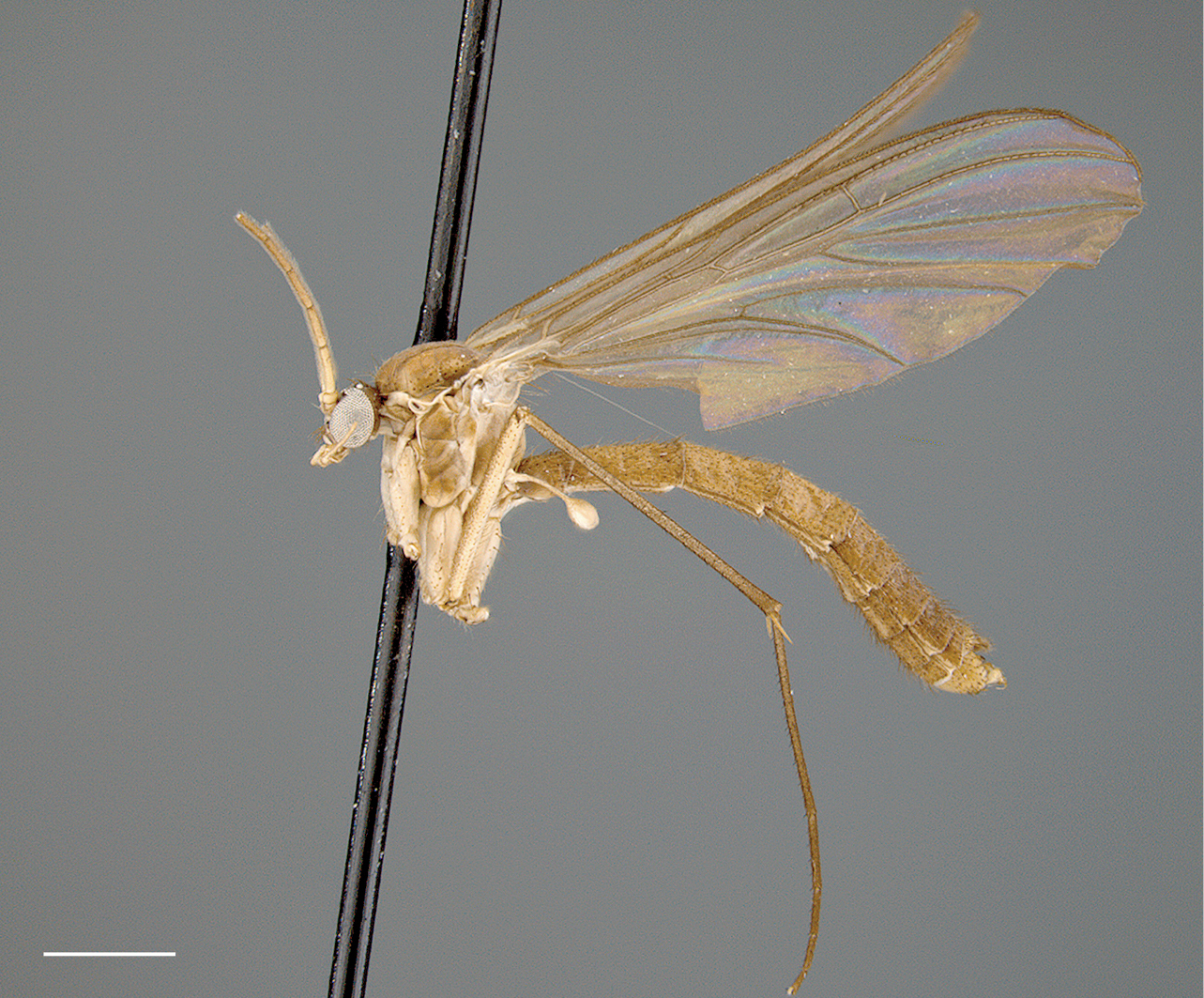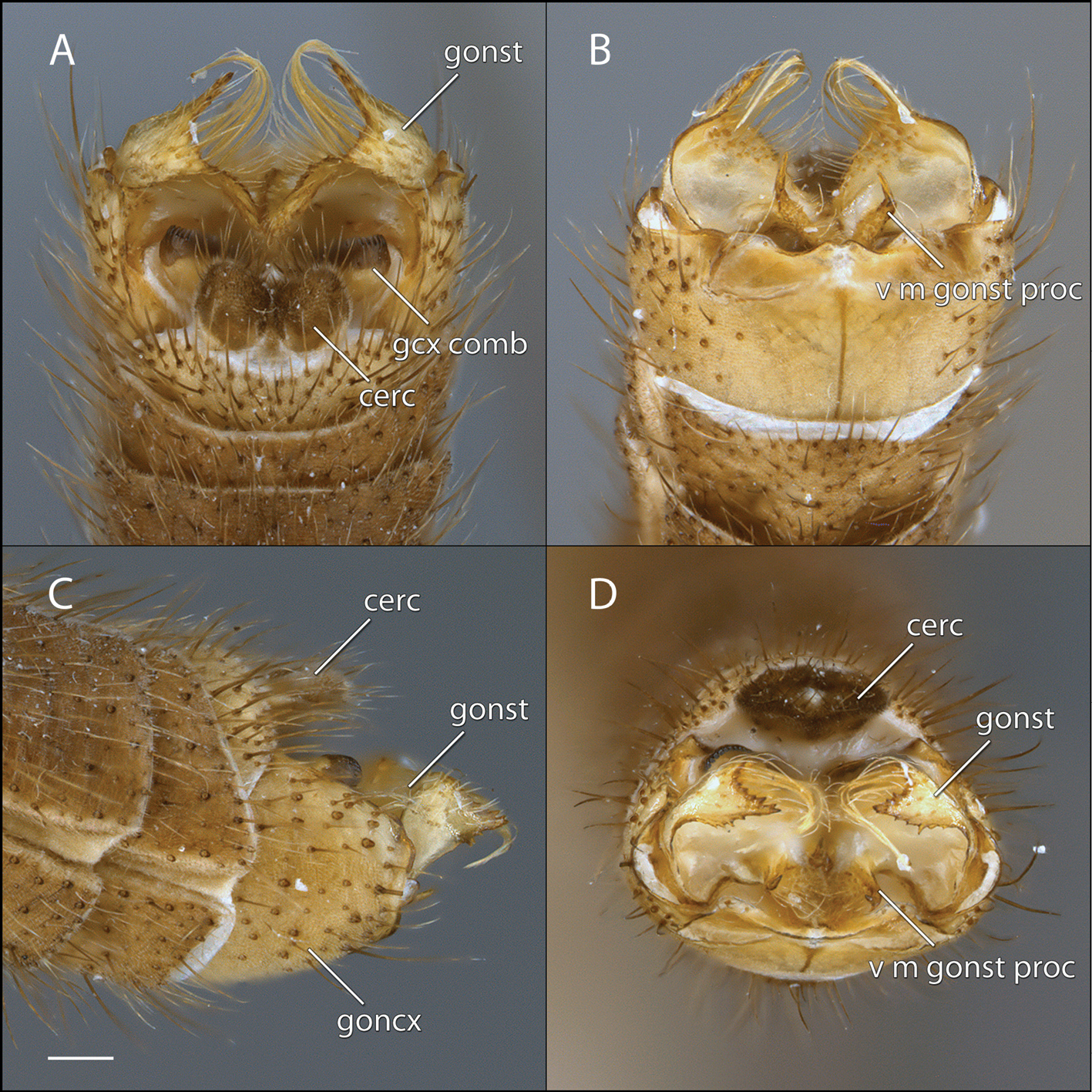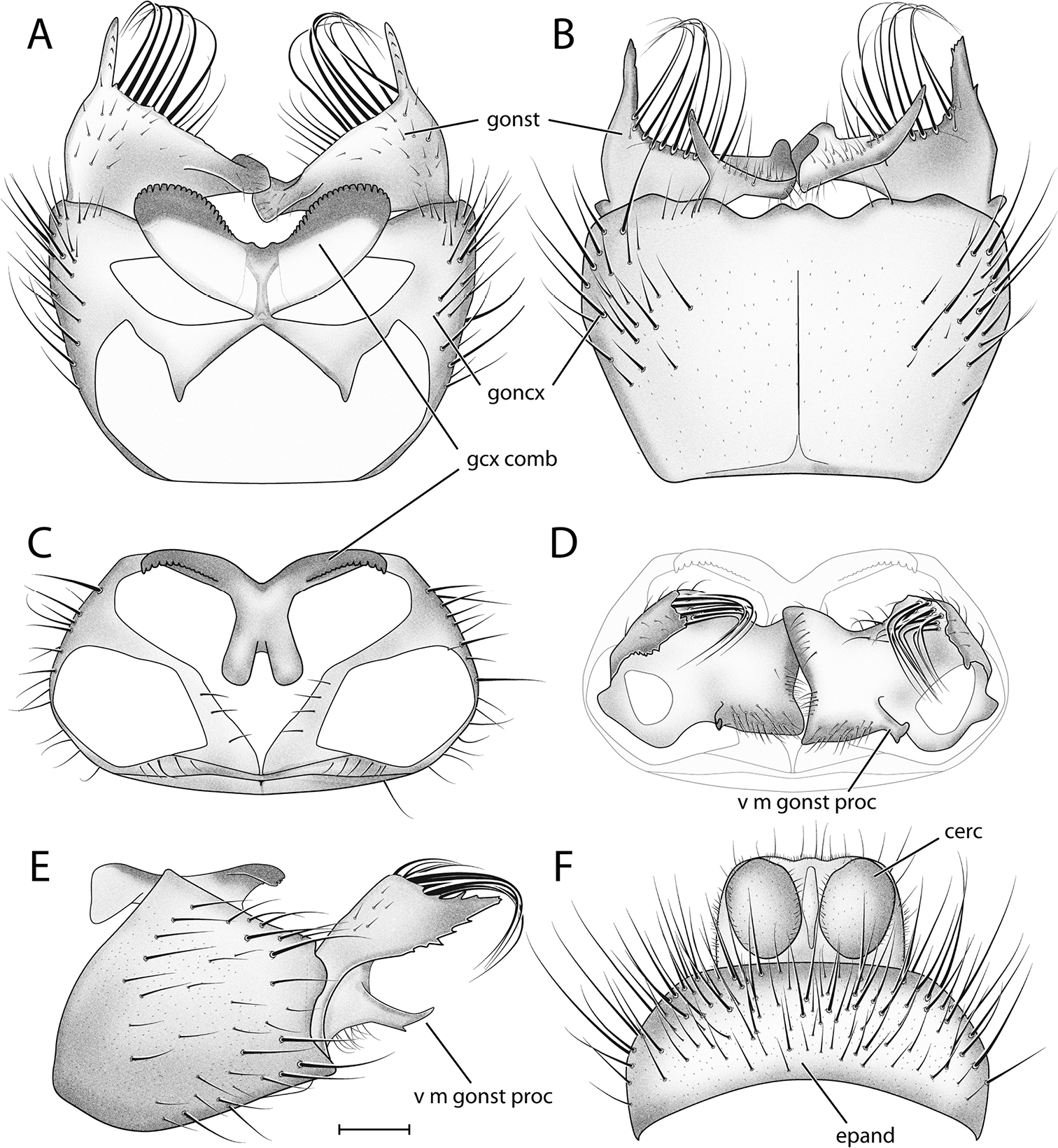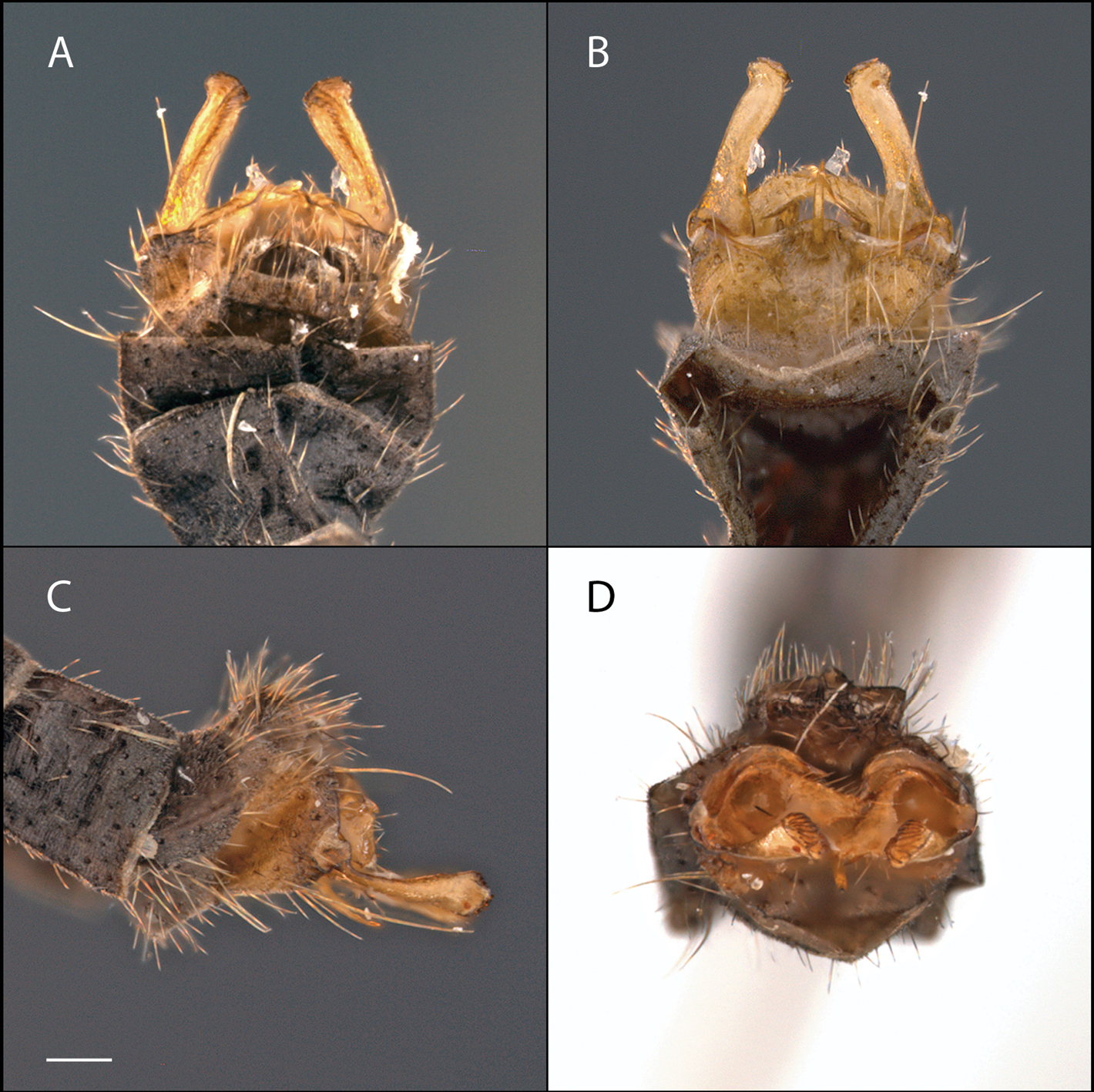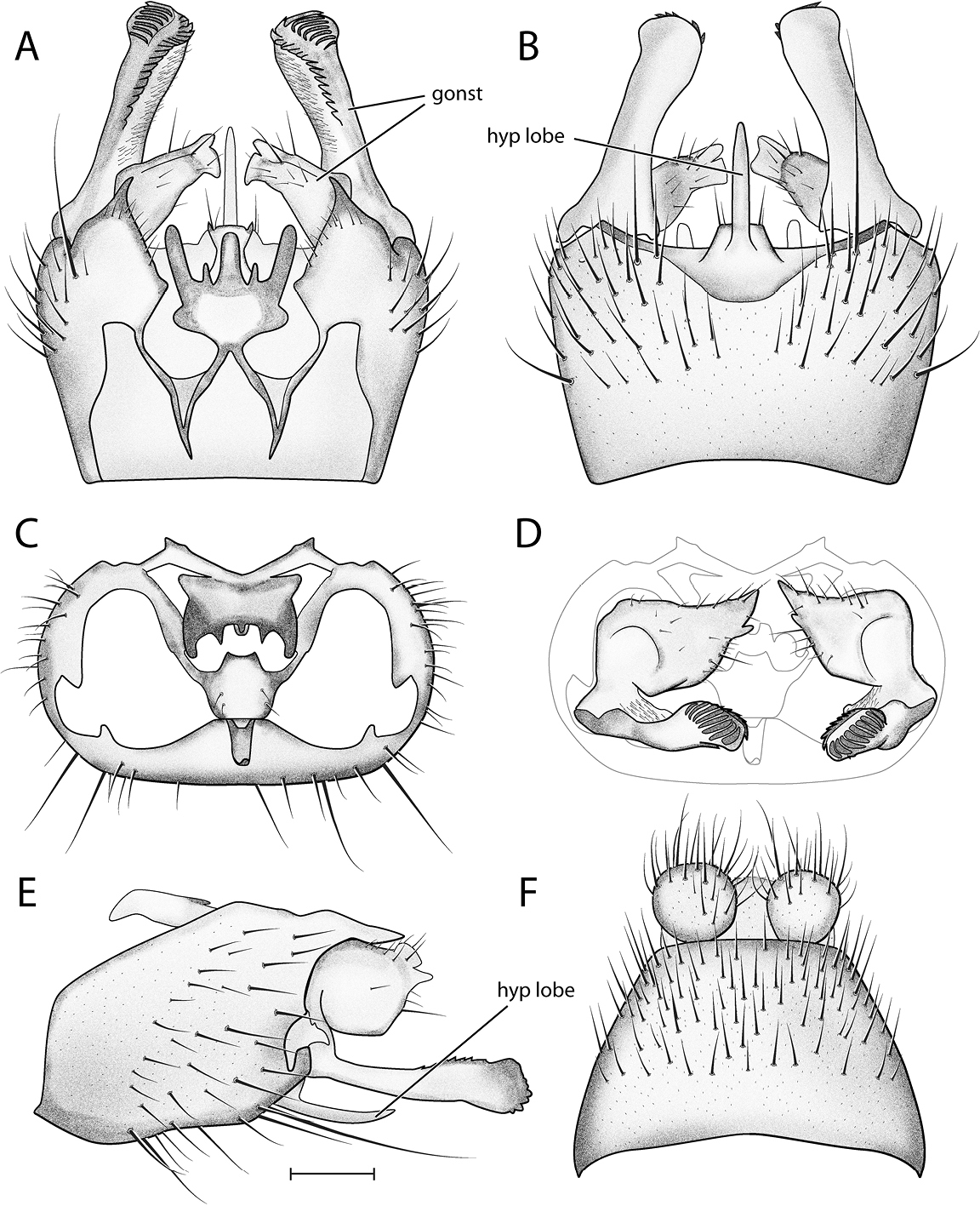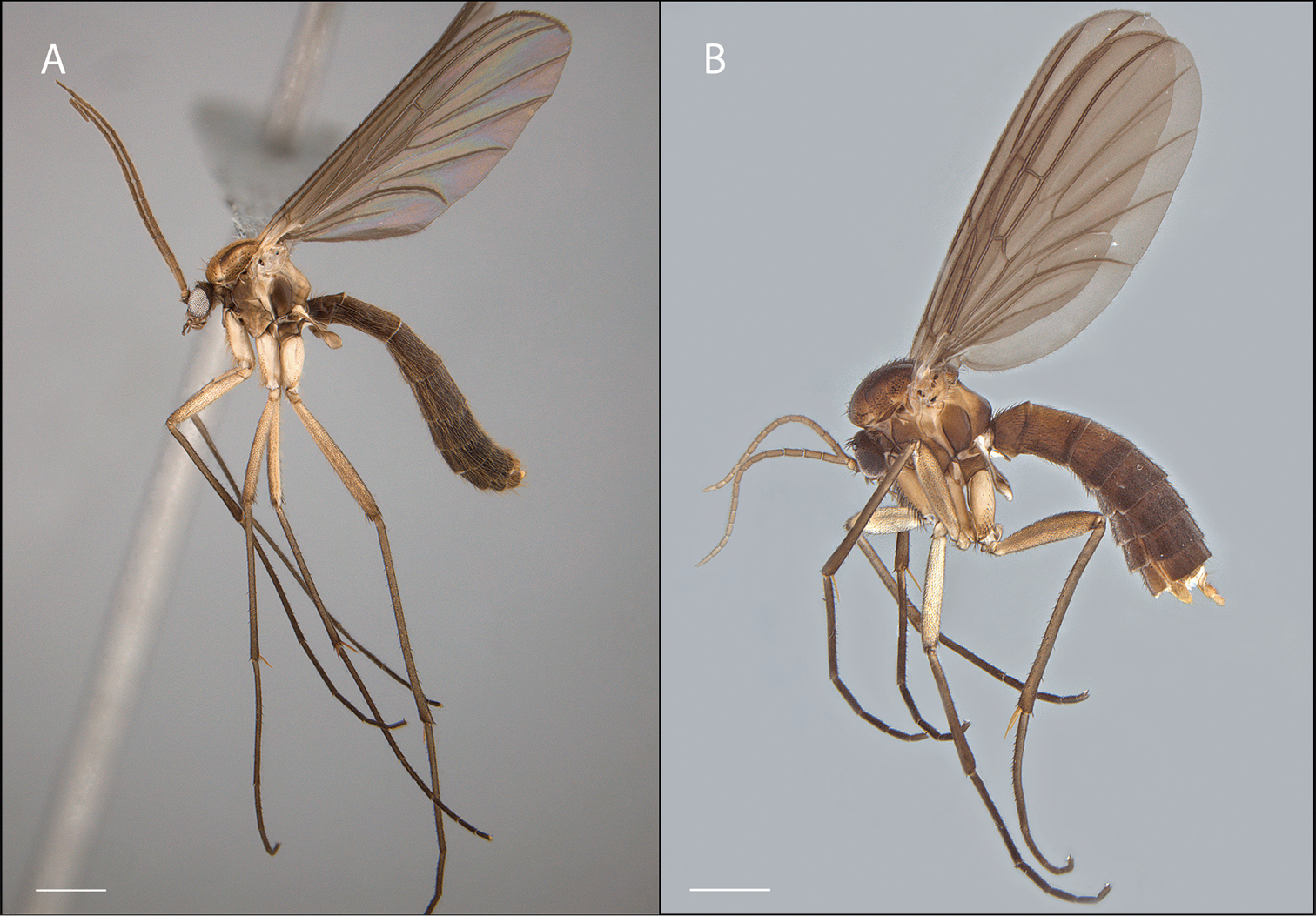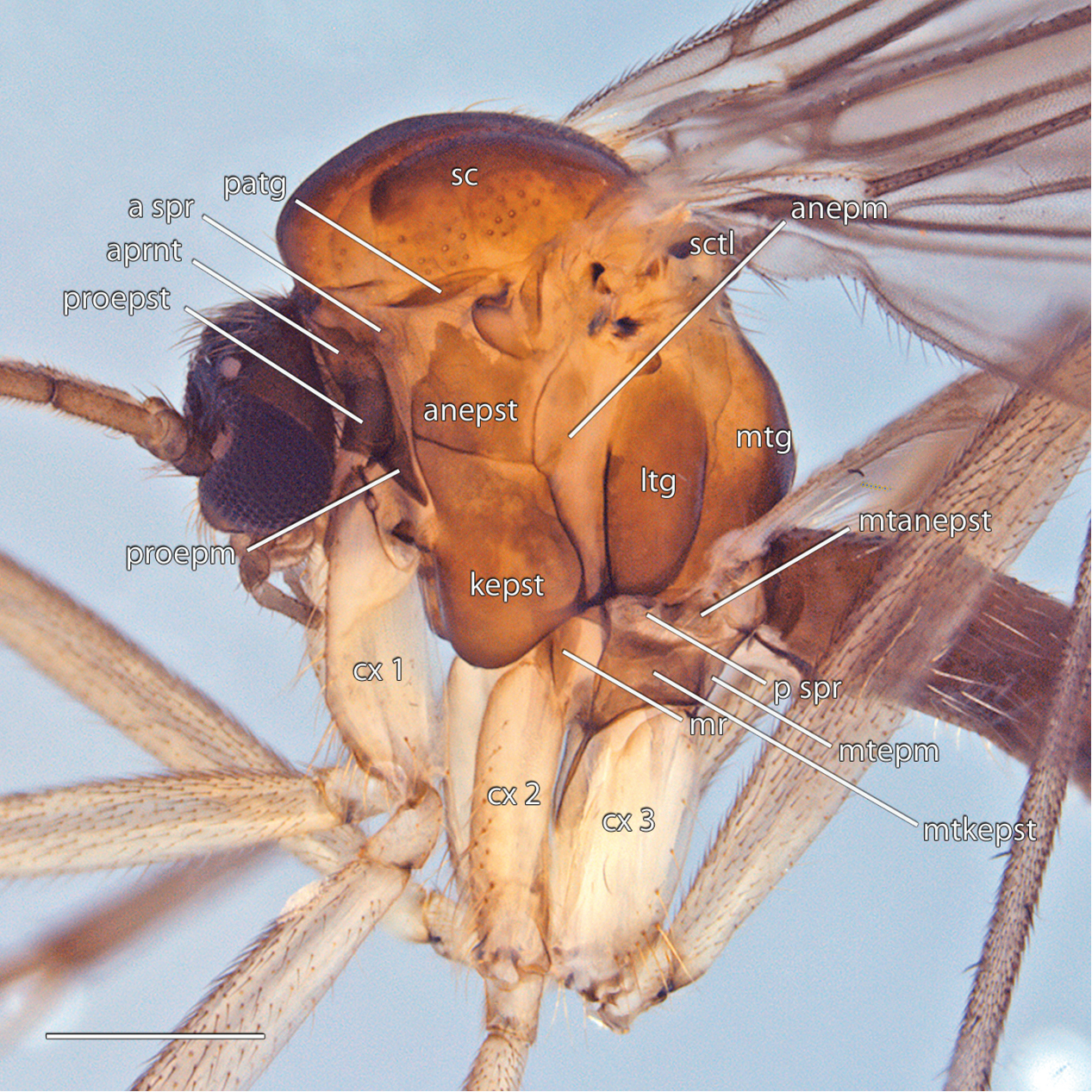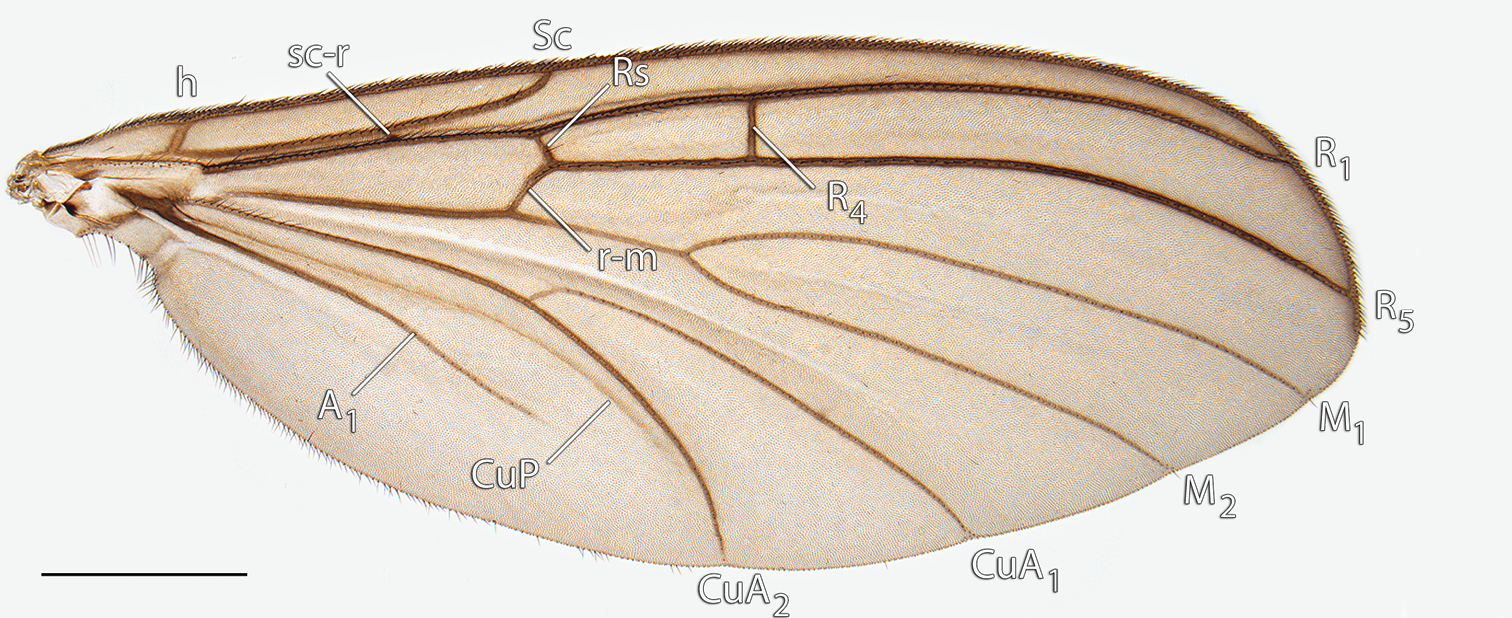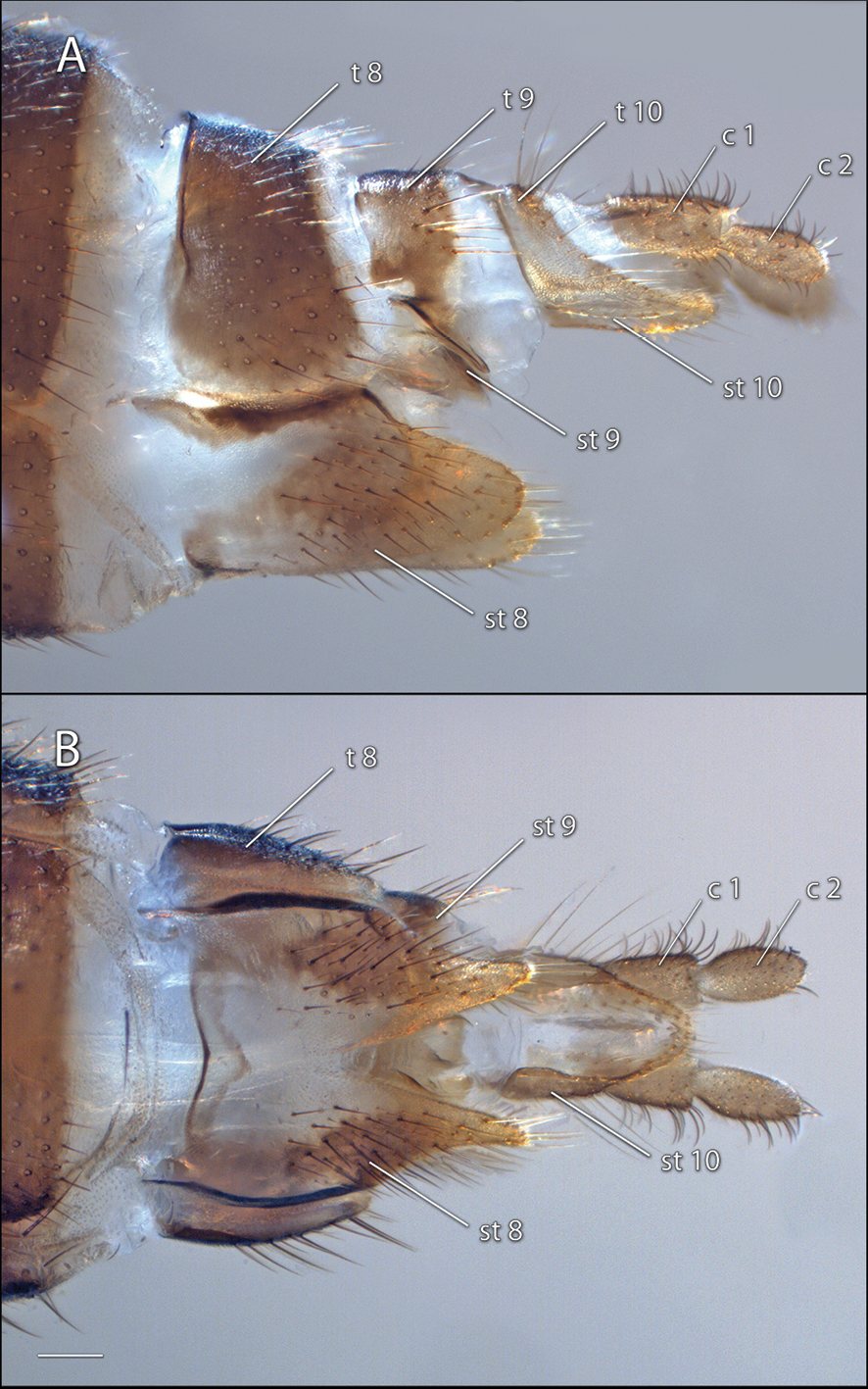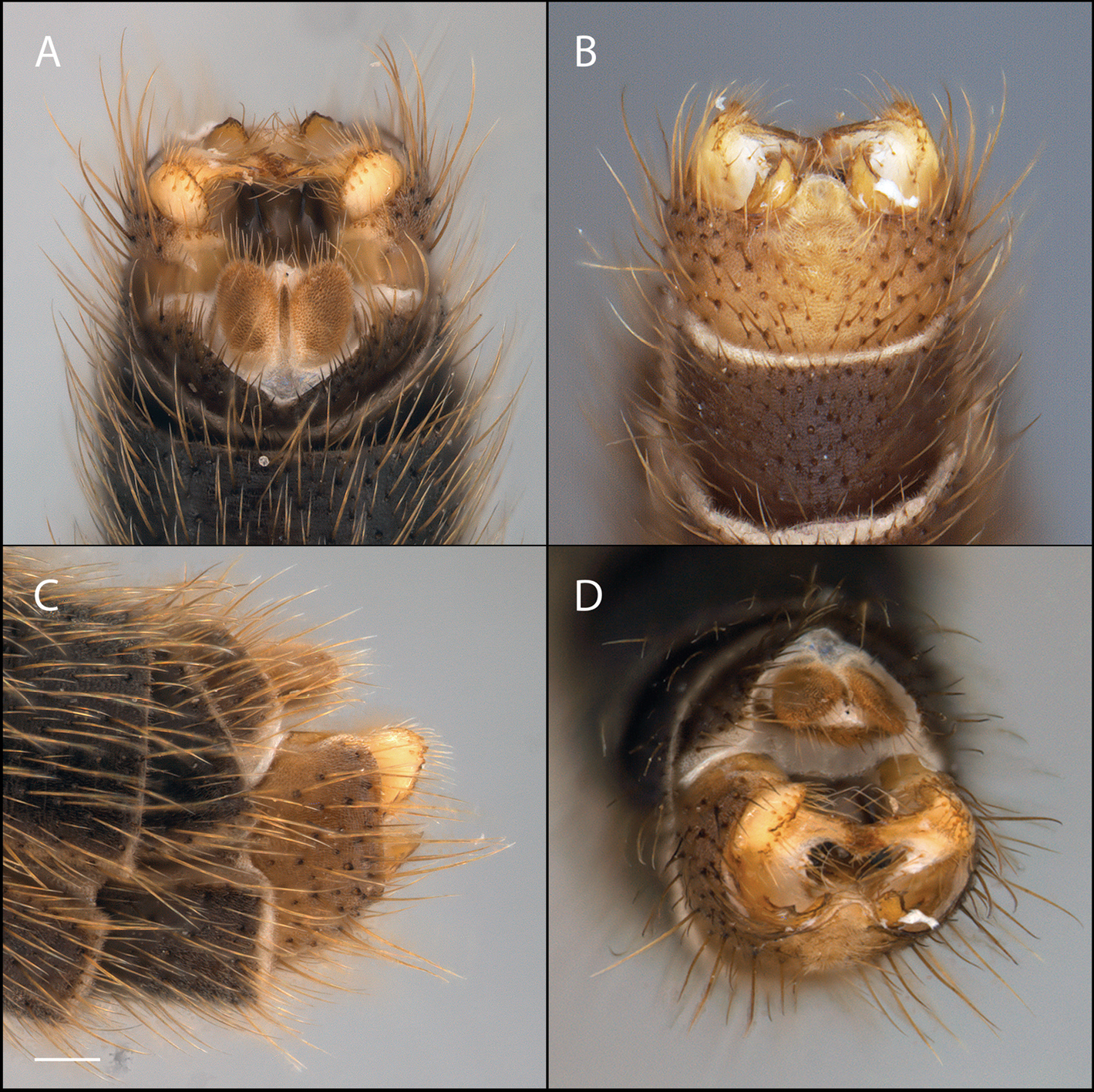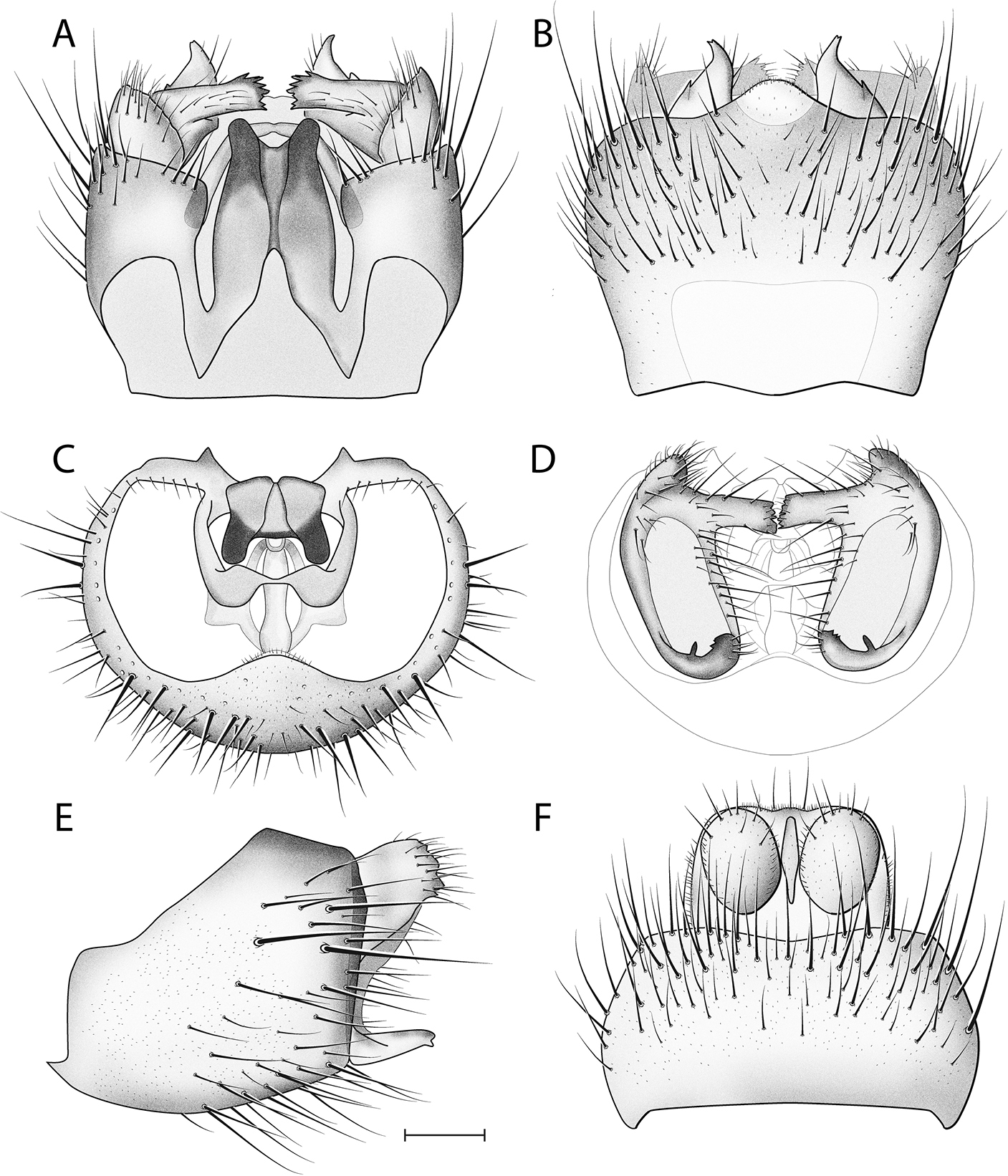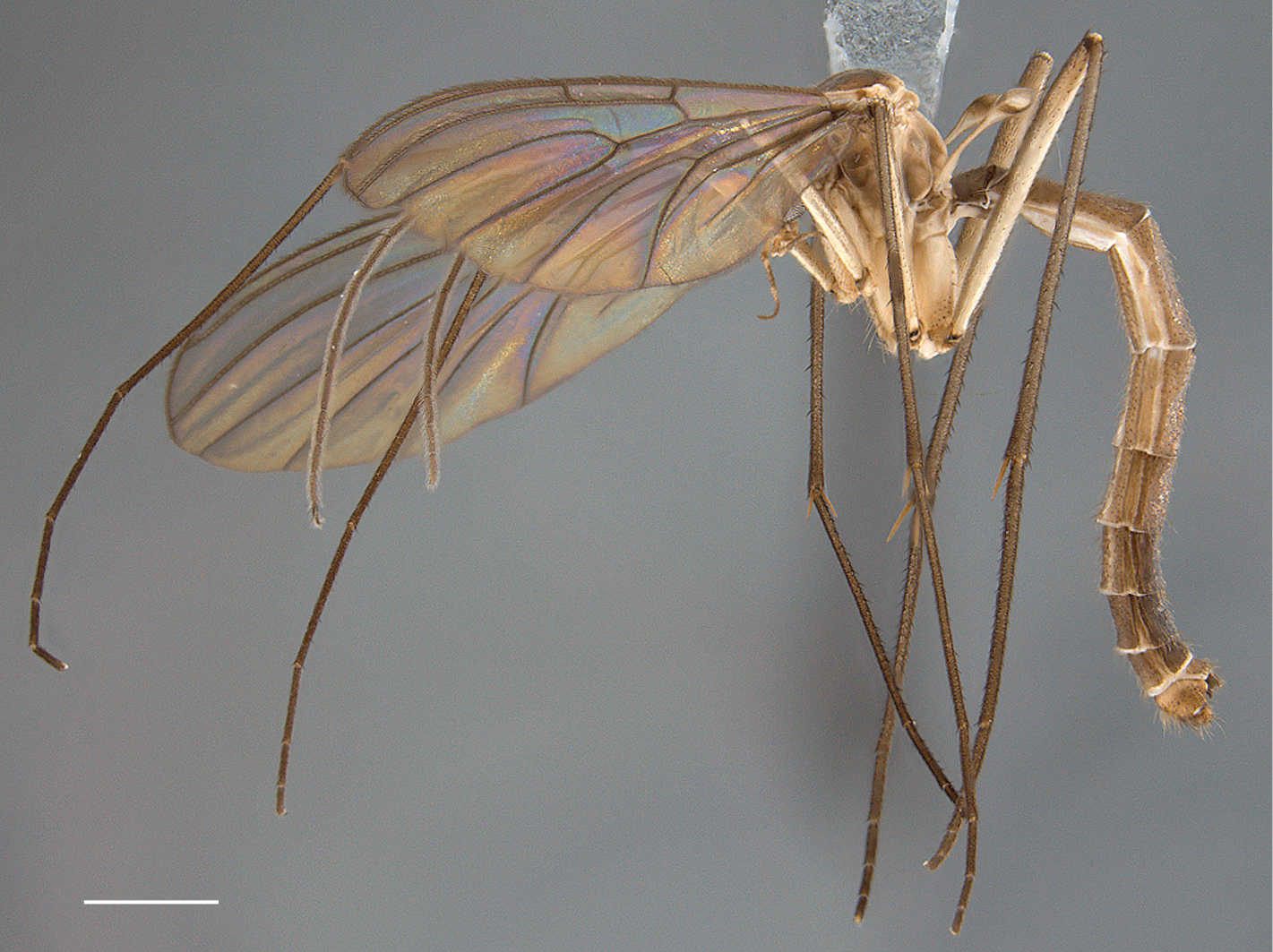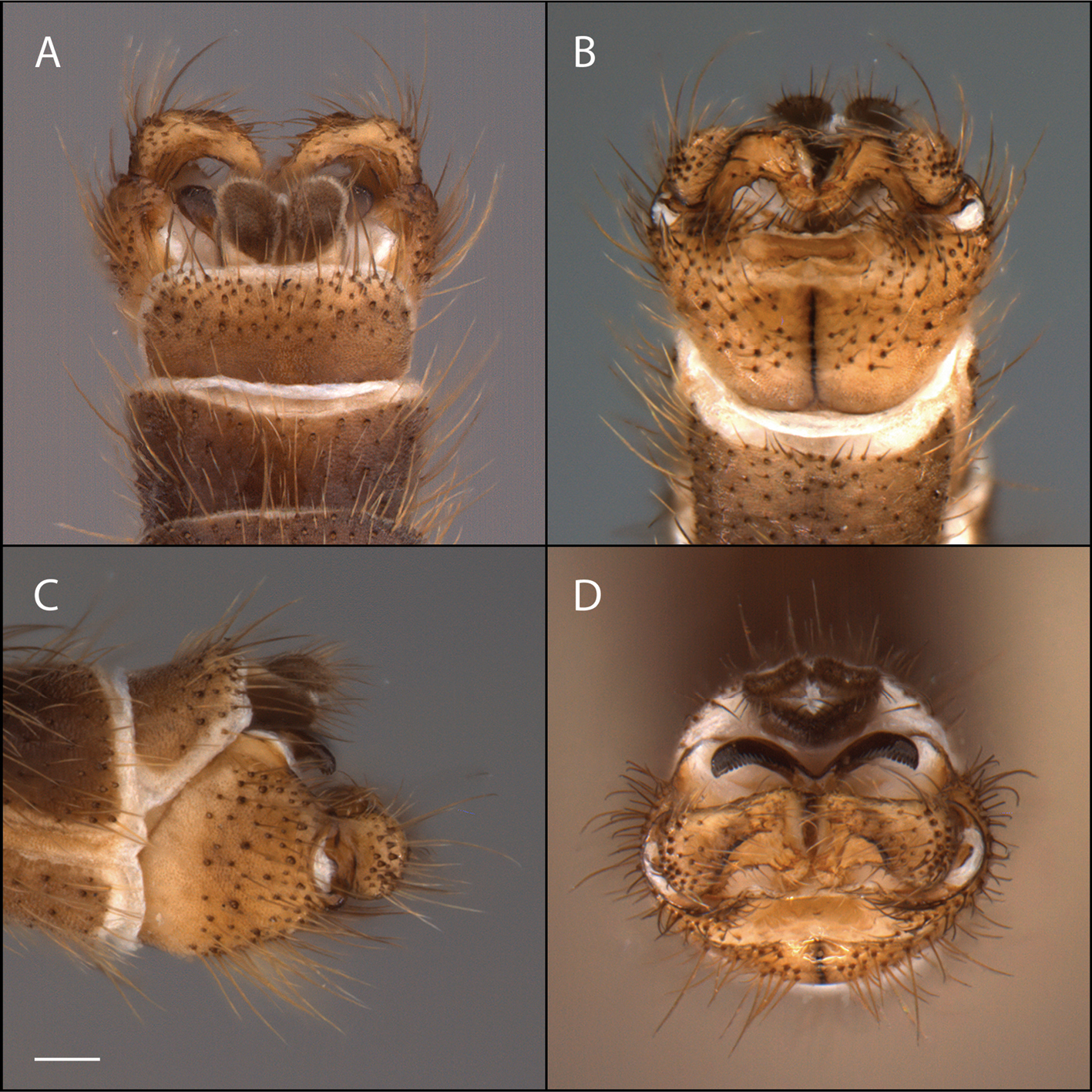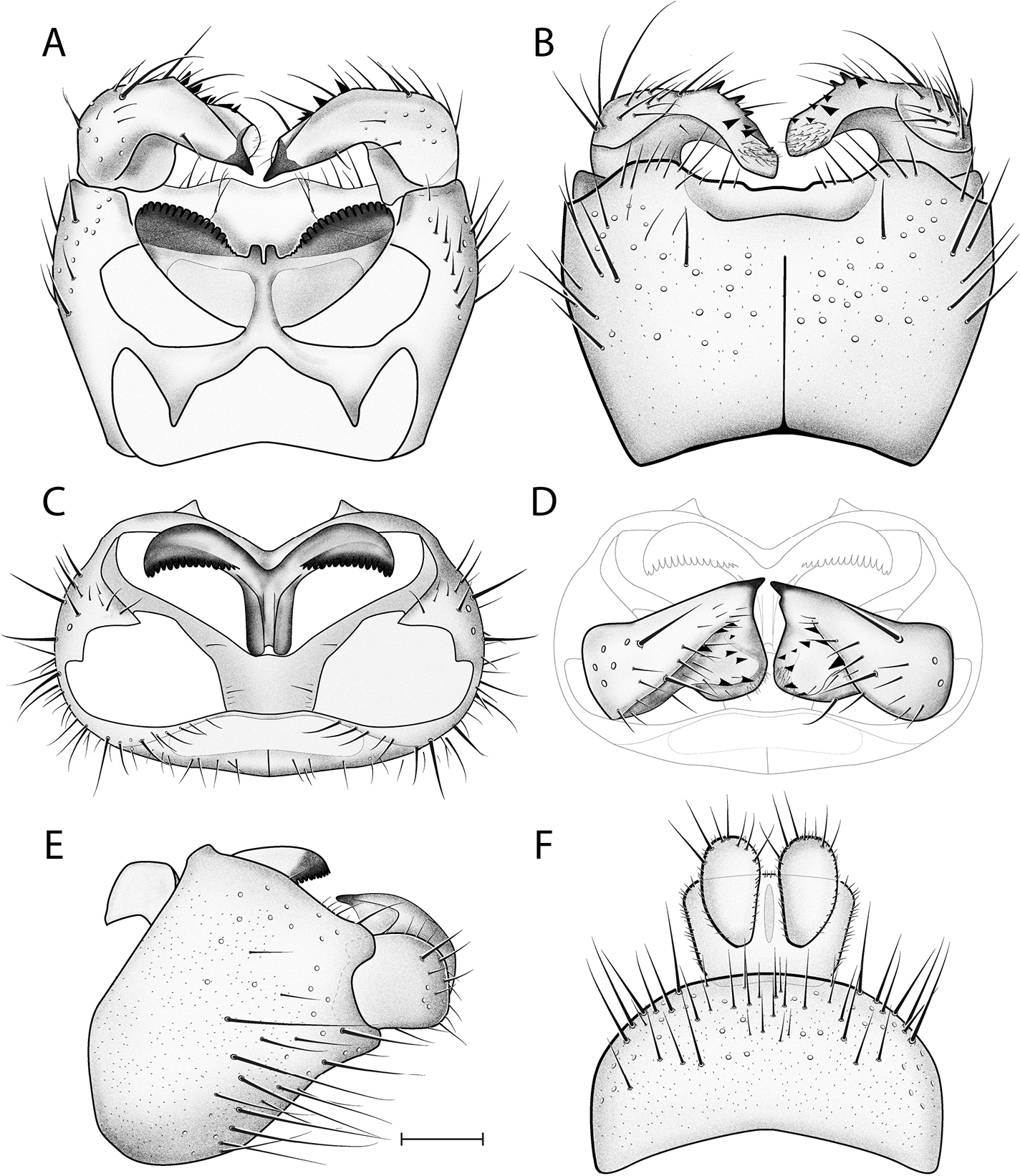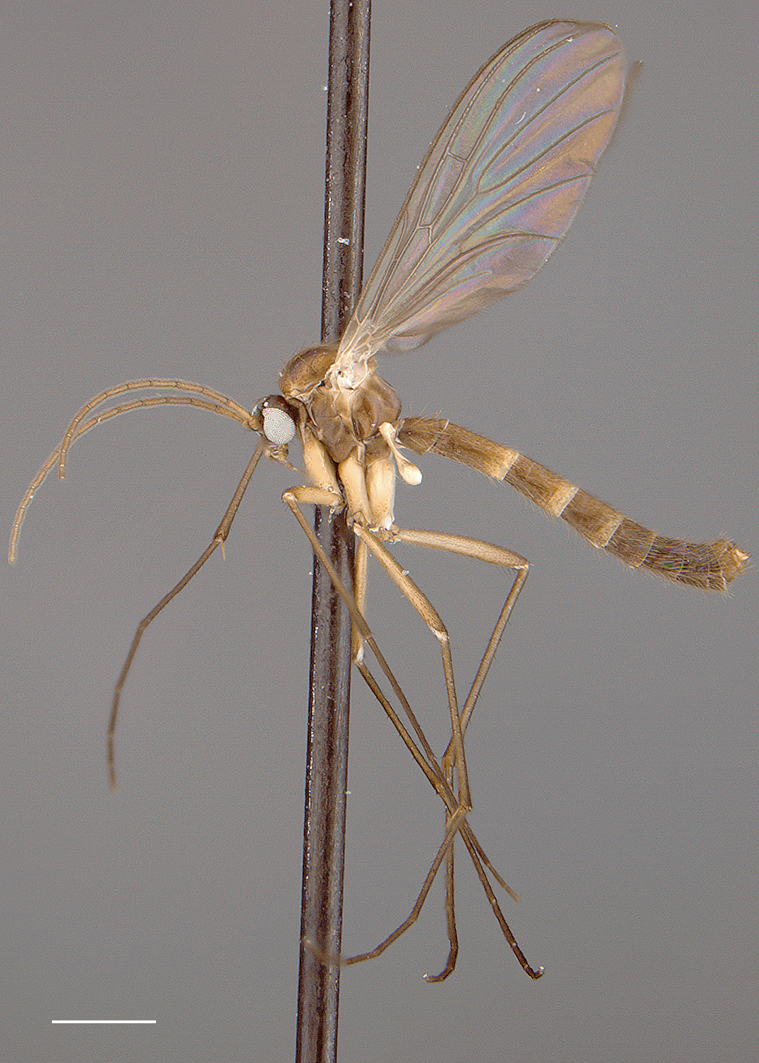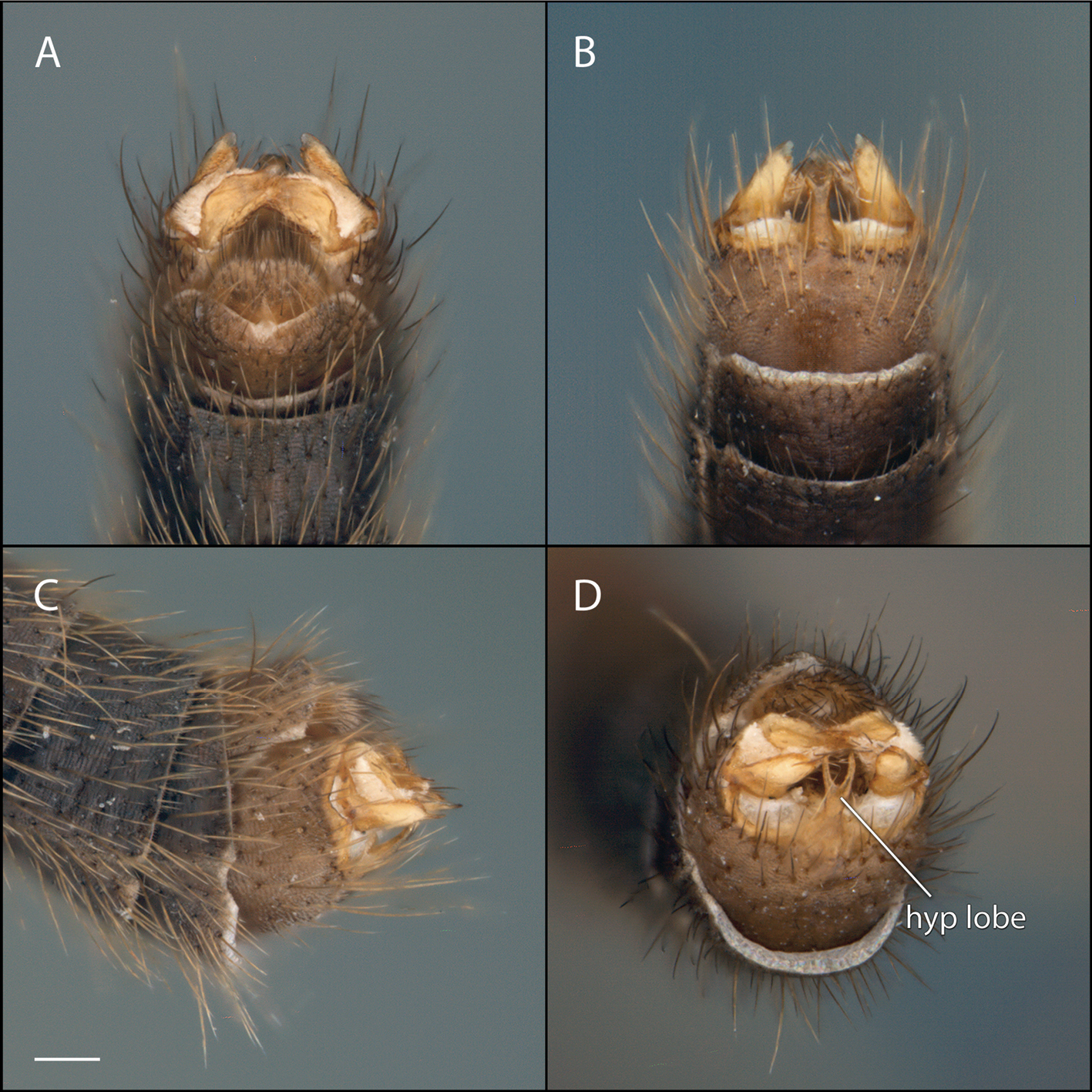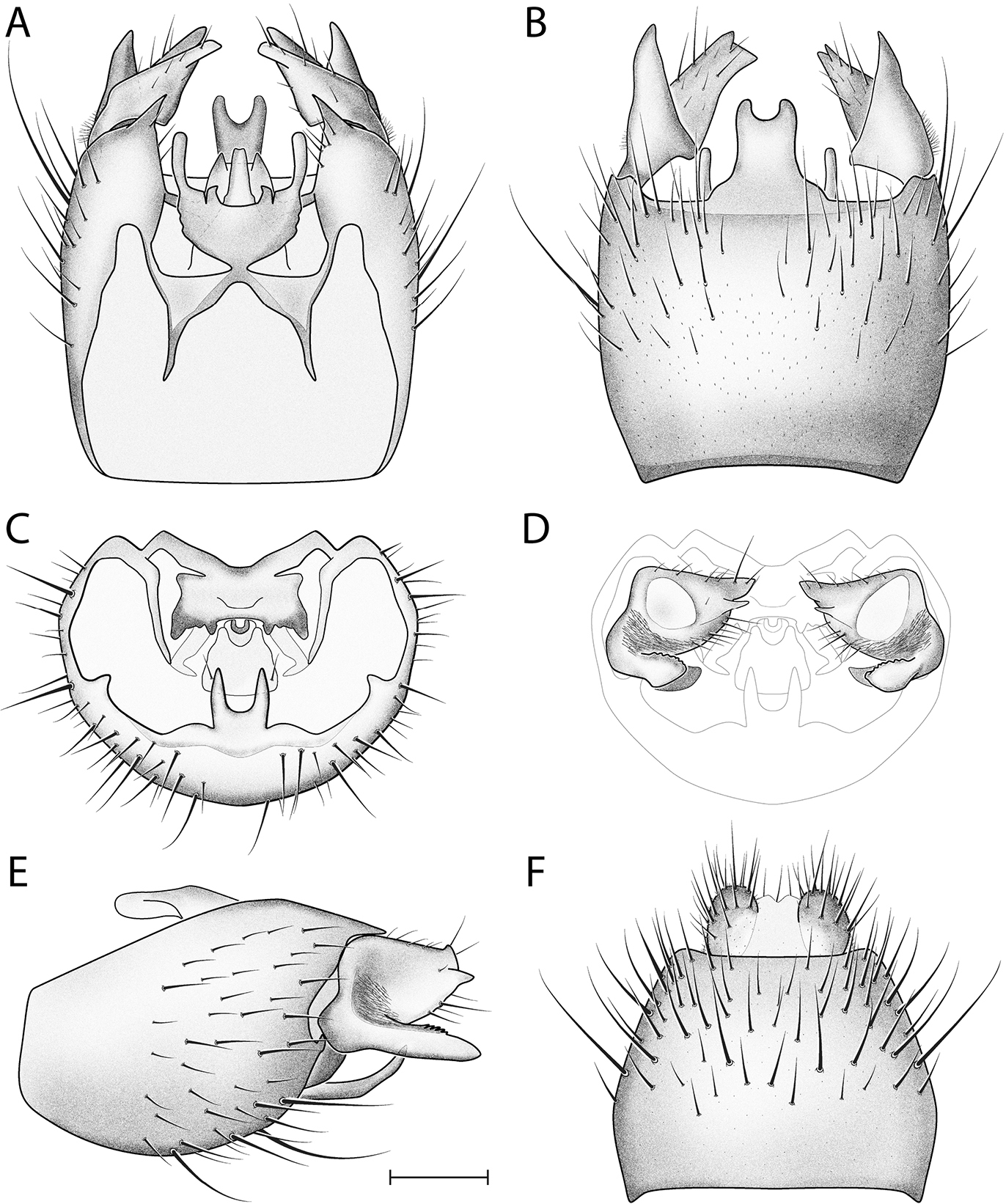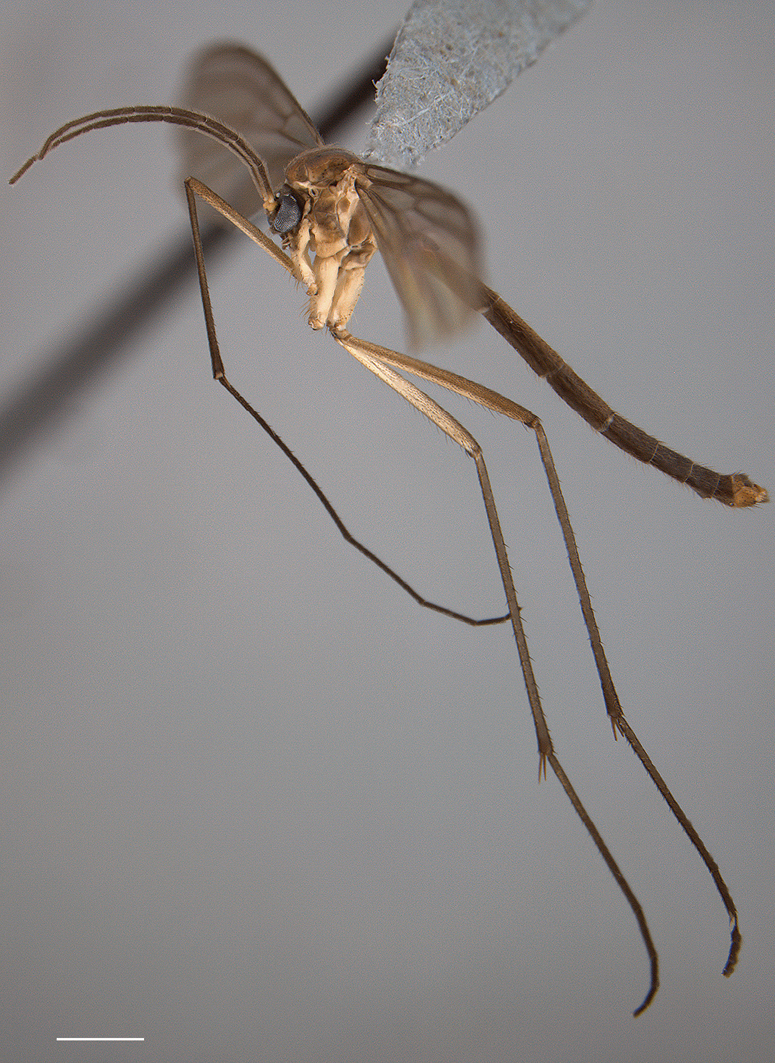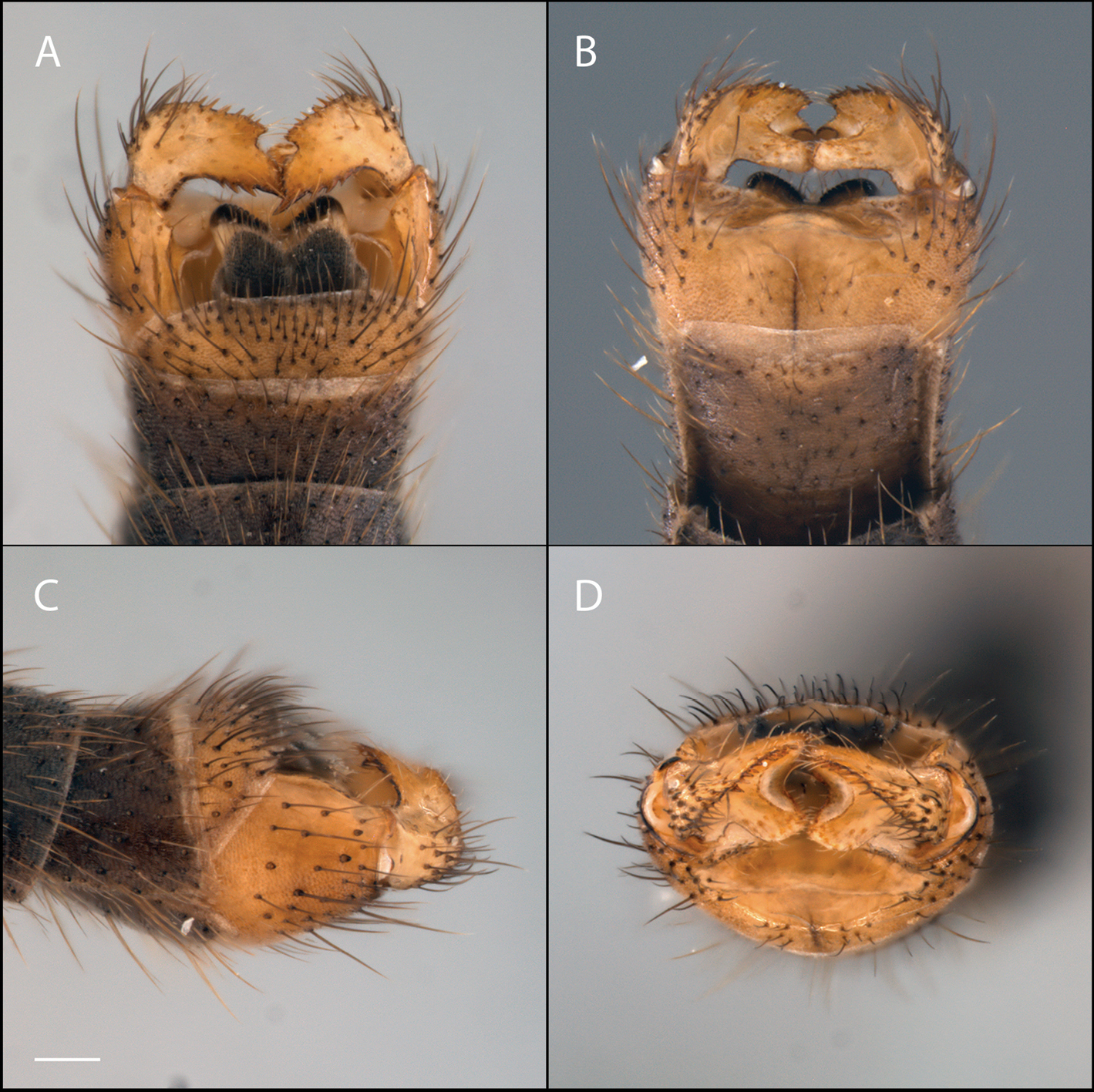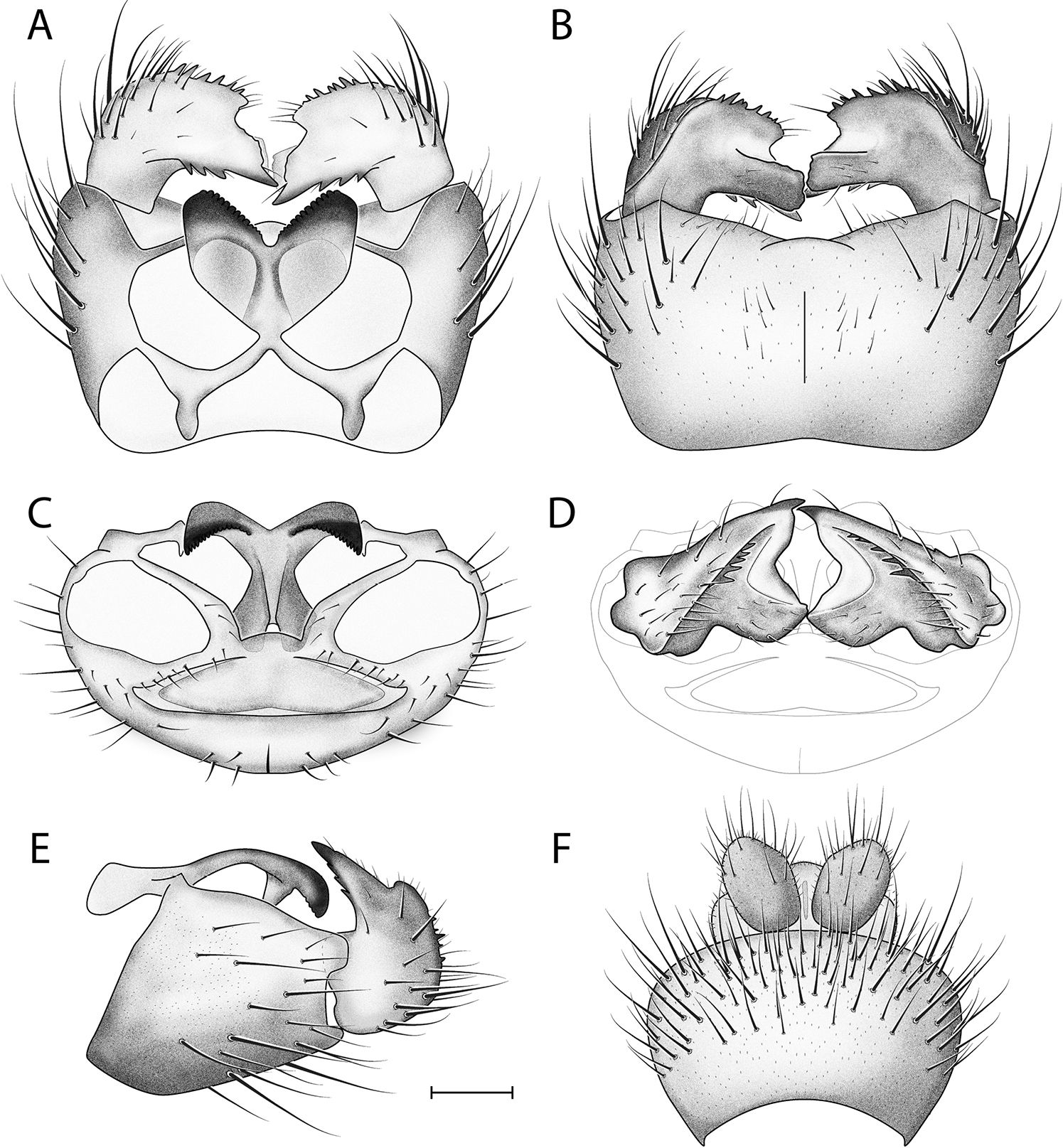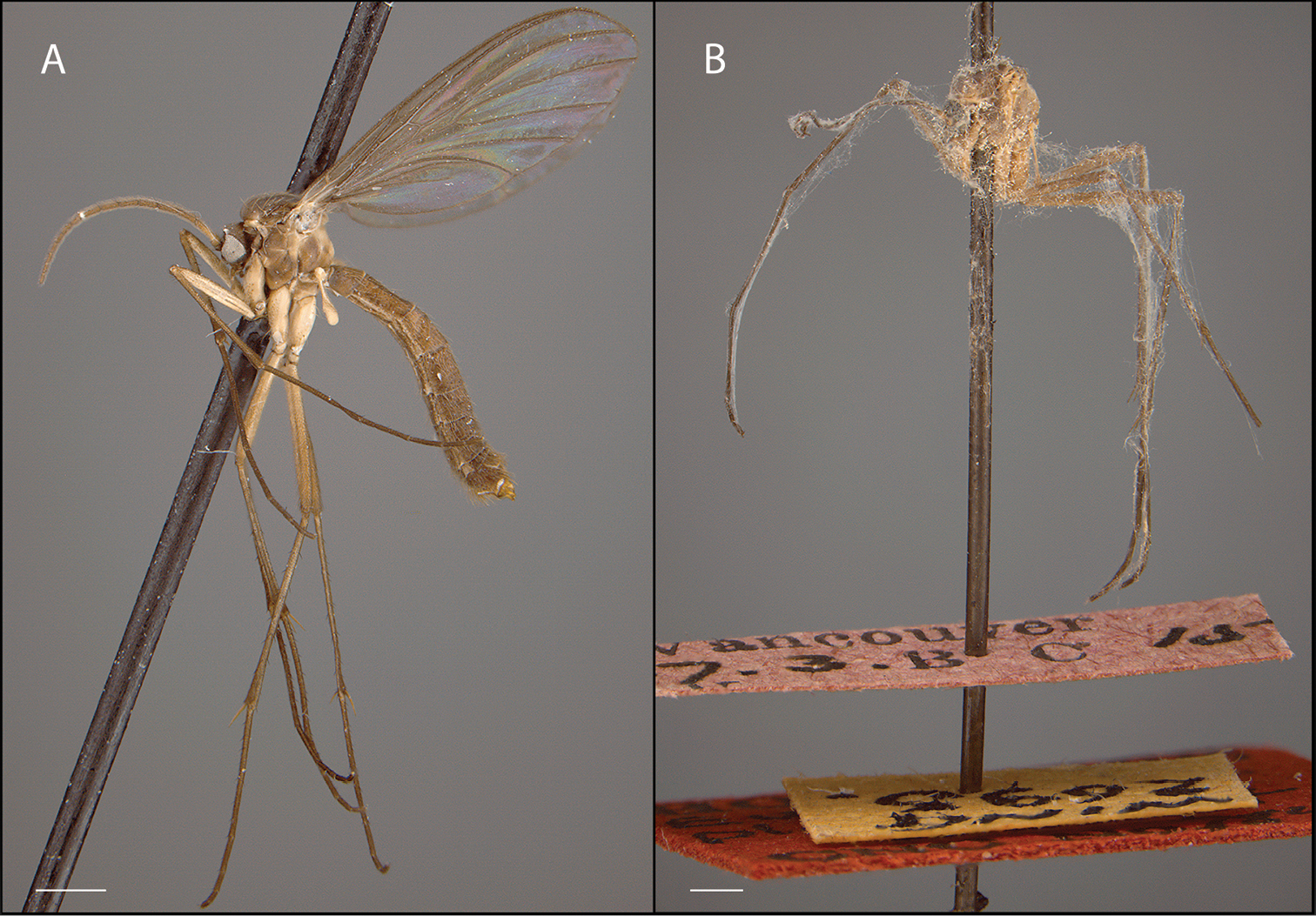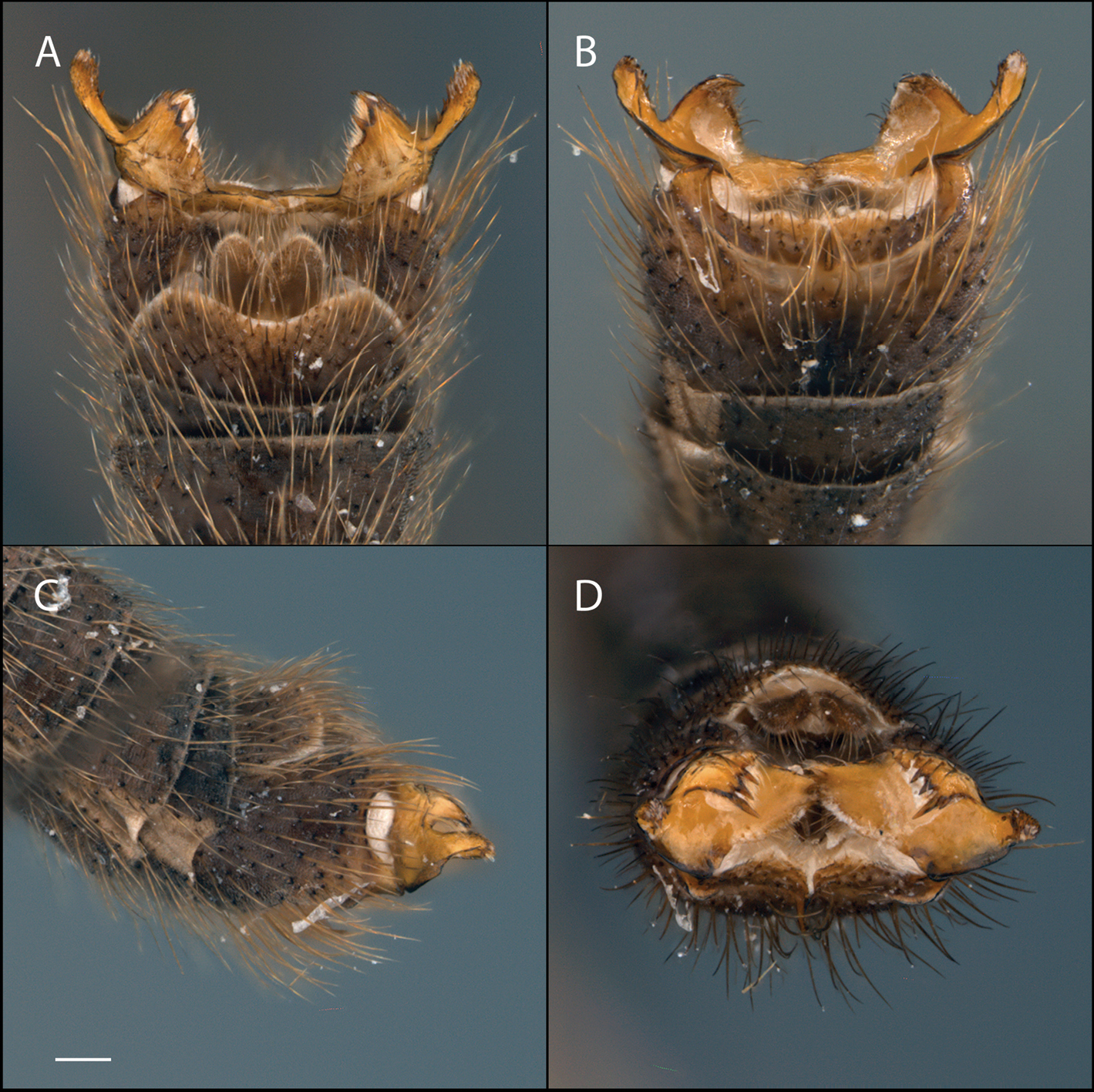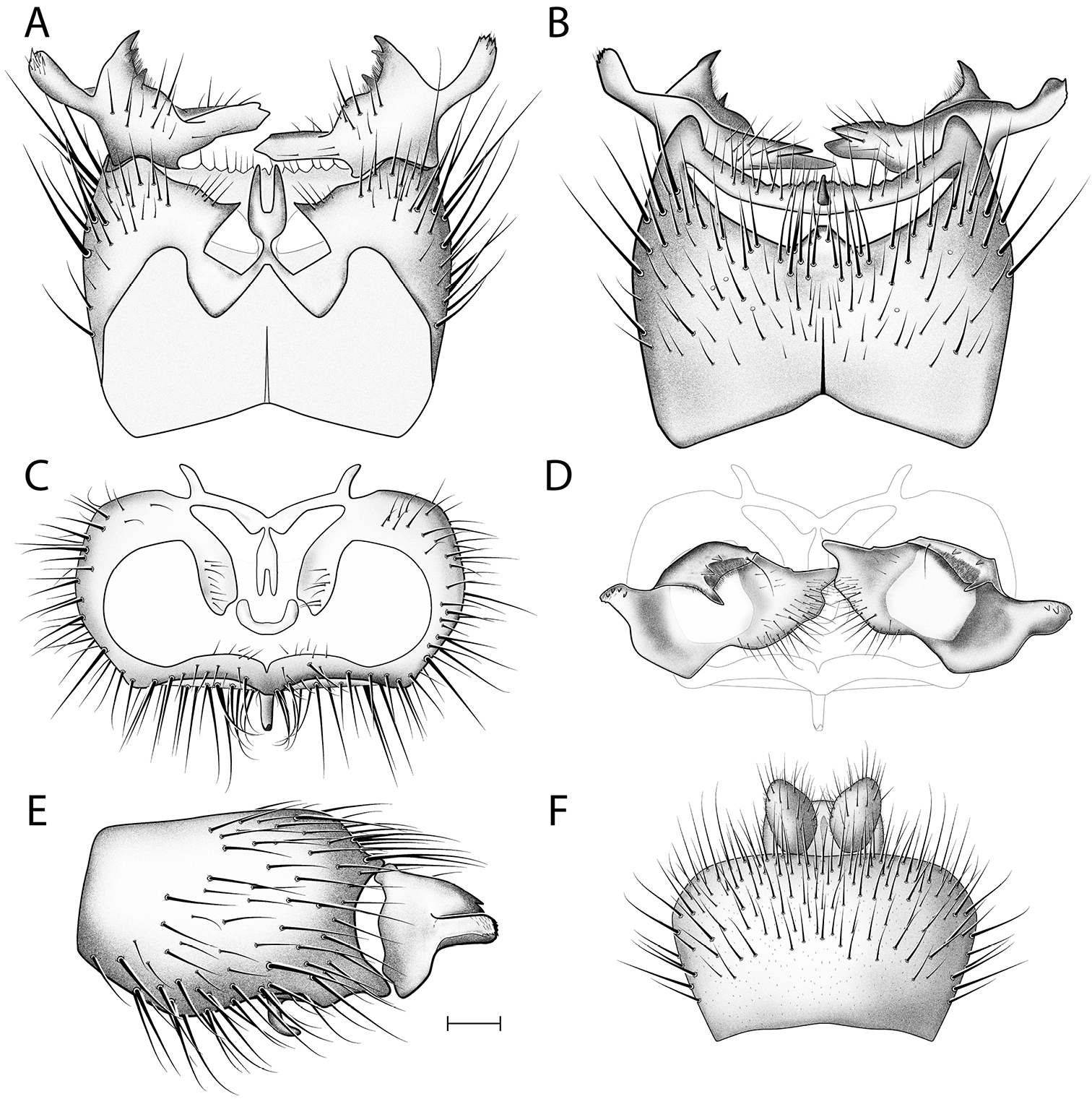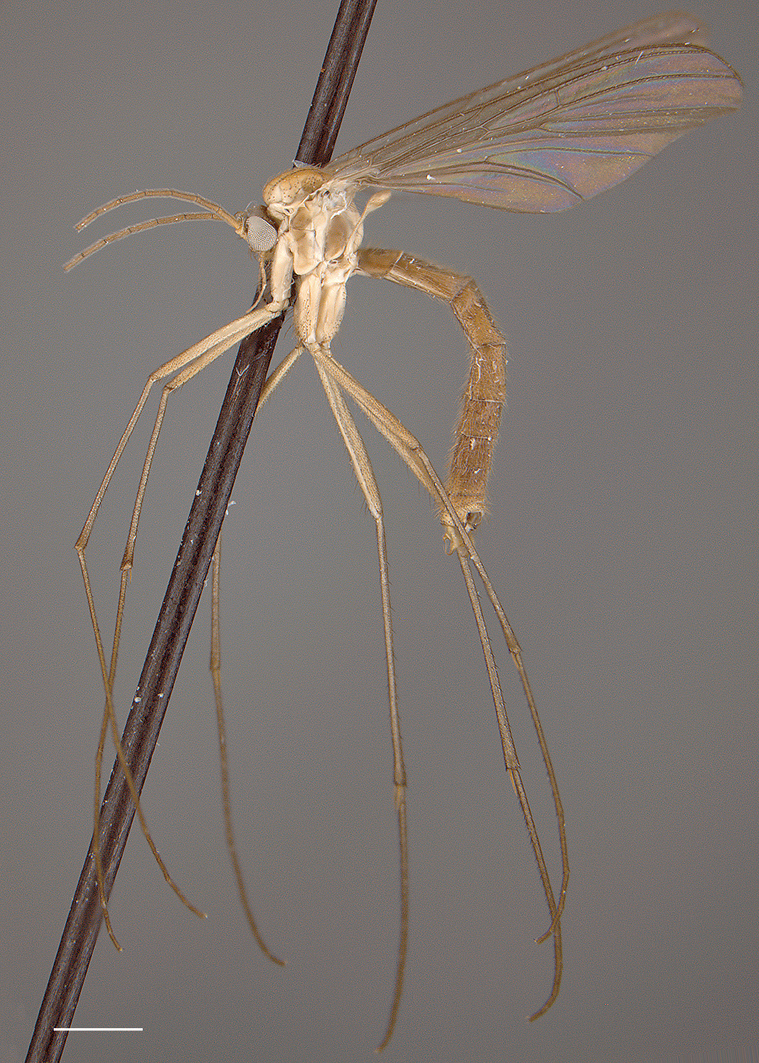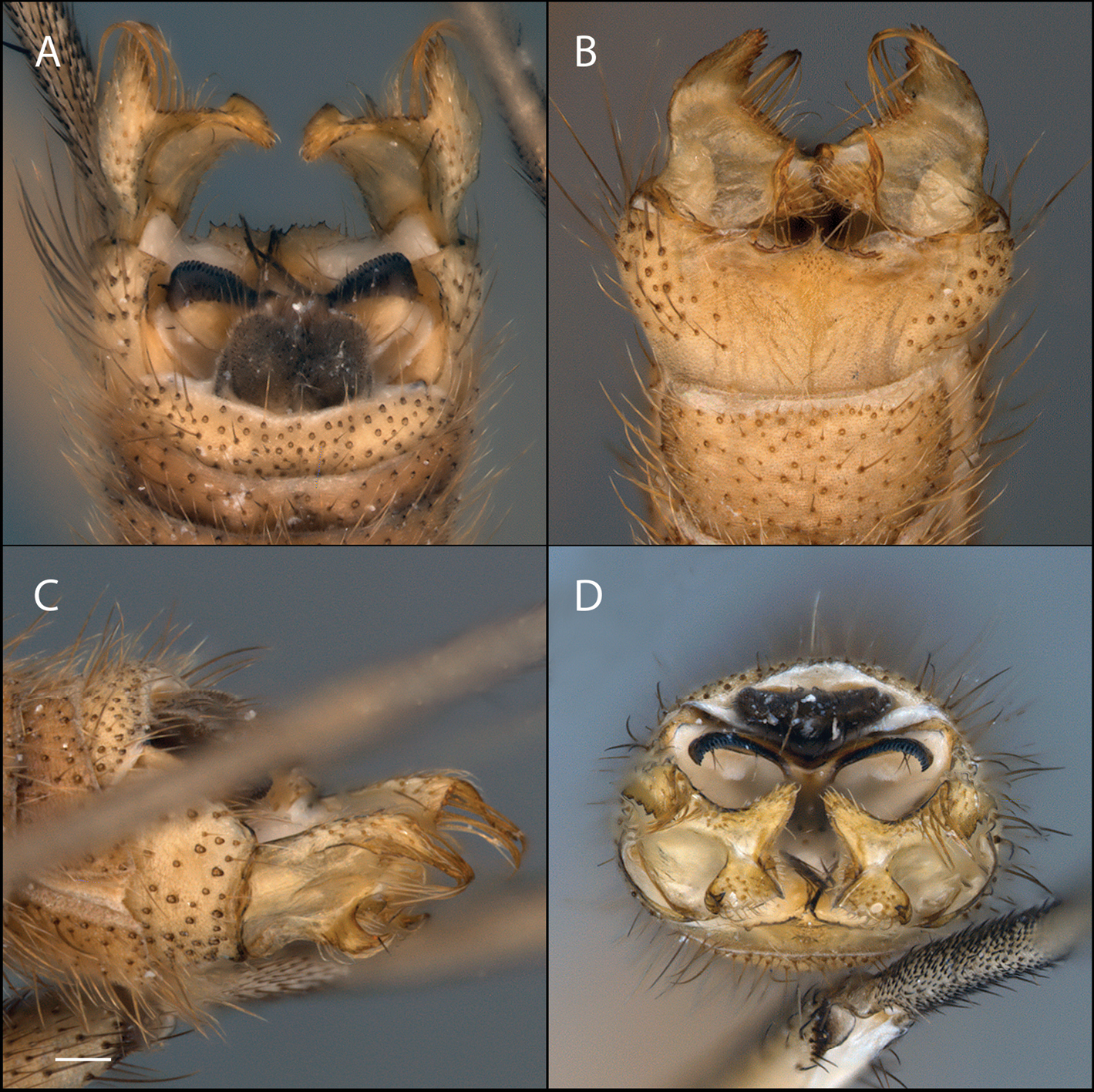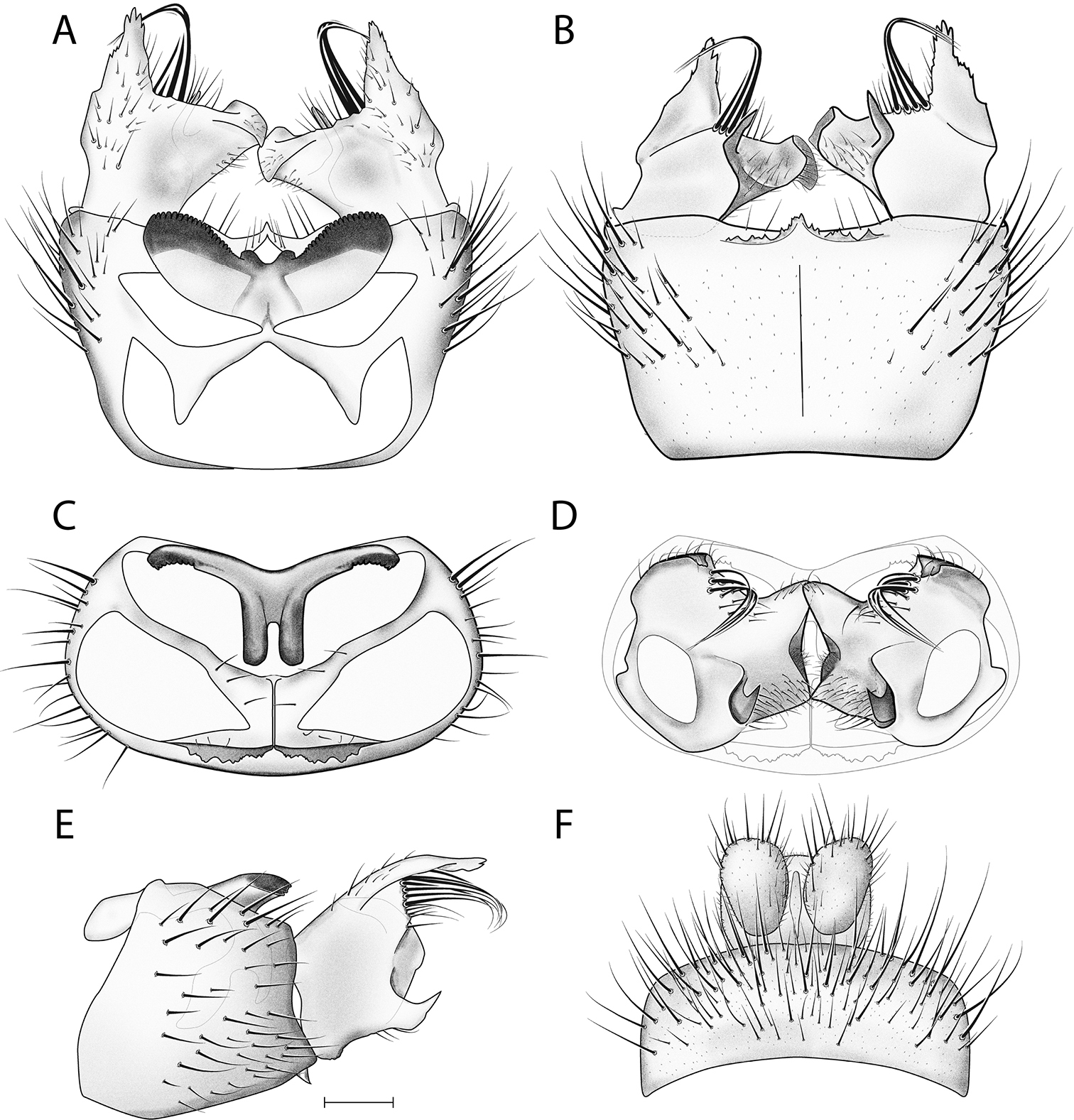






(C) 2011 Peter H. Kerr. This is an open access article distributed under the terms of the Creative Commons Attribution License, which permits unrestricted use, distribution, and reproduction in any medium, provided the original author and source are credited.
For reference, use of the paginated PDF or printed version of this article is recommended.
Six new species are described, raising the number of North American Acomoptera species to seven and the genus total to ten, and nearly doubling the number of species within the putative clade containing Acomoptera, Drepanocercus, and Paratinia. These novel species forms have implications for the concept of Acomoptera that in turn, may impact our understanding of its generic relationships and the evolution and composition of Gnoristinae and Sciophilinae. The new species, Acomoptera crispa, Acomoptera digitata, Acomoptera echinosa, Acomoptera forculata, Acomoptera nelsoni, and Acomoptera vockerothi, are compared with the type species of the genus, Acomoptera plexipus (Garrett), whose diagnostic features are imaged and illustrated for the first time. The European species, Acomoptera difficilis (Dziedzicki) is also illustrated and compared. Acomoptera spinistyla (Søli) comb. n. is transferred from Drepanocercus. A key to species is provided. Future work will seek to incorporate this knowledge into a systematic phylogenetic study of relationships between these species and their sister taxa.
Systematics, Sciophilinae, Sciophilini, Gnoristinae, Gnoristini, Paratinia, Drepanocercus, fungus gnats, new species
The genus Acomoptera (Diptera: Mycetophilidae) was established by
By originally placing the type species in Eudicrana,
This schizophrenic classification history for Acomoptera largely follows the various interpretations applied to Acomoptera's putative sister taxa, Paratinia Mik and Drepanocercus Vockeroth. Paratinia and Drepanocercus have been placed either together in Sciophilinae (
Before investigations into the phylogenetic relationships of Acomoptera and other genera proceed further, it is first important to recognize the diversity of species within Acomoptera itself. The holotype of the type species, Acomoptera plexipus (Garrett), is a female and now badly damaged and covered by fungal spores (Fig. 21B).
Here, an additional six new species are described, raising the number of North American Acomoptera species to seven. These new species are compared with Acomoptera plexipus (Garrett), whose diagnostic features are imaged and illustrated. The European species, Acomoptera difficilis is also illustrated and compared. A key to species of the genus is included and apparent phylogenetic affiliations between congeners are briefly discussed.
Materials and methodsTerminology for wing venation generally follows McAlpine (1981), however interpretation of radial veins consistent with
Eudicrana plexipus Garrett, 1925: 4, by subsequent designation.
This genus may be distinguished from most mycetophilid genera by the following combination of wing characters: Sc ending in C, sc-r present near middle of Sc, and R4 present and displaced from Rs by more than 2.5× its own length. Acomoptera may be distinguished from Paratinia by having wing membrane bare and from Drepanocercus by having the cubital fork near the level or distad of sc-r. Acomoptera is distinguished from Phoenikiella Chandler by having a setose Sc, with sc-r positioned near the middle of this vein.
Body length 4.5 to 7.1 mm. Ocelli three, subequal or median ocellus reduced, lateral ocellus separated from eye margin by approximately its own diameter or clearly less. Eye with a broad distinct emargination above antennal base, with microsetae usually scattered and short, but sometimes more numerous and longer. Frons bare between ocelli and antennal bases. Frontal tubercle present. Antenna two to four times as long as thorax, 2/3rds to approximately same length as abdomen; antennal bases nearly touching, separated only by narrow tip of frontal tubercle; all flagellomeres densely setulose, elongate, flagellomere length decreases gradually toward tip. Palpus with five palpomeres; palpomere 1 short, as wide as long, remaining palpomeres longer than wide (except sometimes palpomere 2 as wide as long); palpomere 2 clearly shorter than or subequal to palpomere 3; palpomere 4 three to six times longer than wide; palpomere 5 thinner than others, six to eleven times longer than wide, usually subequal to combined length of palpomeres 3 and 4. Scutum with short appressed acrostichal and dorsocentral setae and longer and more erect sublateral setae, the intervening areas bare. Scutellum with three or four irregular rows of short to long setae, sometimes bare medially. Paratergite present; antepronotum with setae on posterior half, proepisternum bare; mesopleuron, metapleuron, and prosternum bare; metanotum with one to three erect setae laterad of base of halter; mediotergite and laterotergite bare; phragma not well developed. Wing unmarked, with dense microtrichia, without macrotrichia. Costal vein extends beyond R5, between approx. 0.25× and 0.33× distance between R5 and M1; sc-r crossvein present, slightly distad of middle of Sc, proximal of Rs; R4 present (when missing, teratogenic), located approx. 3× its own length from Rs, forming an elongate radial cell; medial fork approx. 3× longer than stem; cubital fork arises near level or distad of sc-r and proximad of medial fork, cubital stem shorter than CuA1 and approx. equal in length to or longer than CuA2; all cross veins bare on upper surface, all longitudinal veins setose on upper surface, except CuP and the first two sections of M bare (as an exception, Acomoptera crispa sp. n. may have a few setae on M1+2); wing veins R1, R5, M1, and sometimes M2 with at least some setae on lower surface. Hind coxa with a single vertical row of setae on at least proximal half (sometimes weak). Tibial bristles short but distinct, the longest between half and full tibial diameter in length. Anteroapical depressed area of fore tibia ovate and well developed. Tibial spur pairs of equal length, hind tibial spurs usually longer than mid tibial spurs, but sometimes mid and hind spurs subequal in length. Tarsal claws each with one or two small ventral teeth. Empodia small. Sternite 1 bare. Sternites 2 to 7 each with a pair of broad, poorly defined, submedian to sub lateral fold-lines. Terminalia not rotated. Epandrium (tergite 9) between three times as wide as long to slightly wider than long. Hypandrium (sternite 9) fused with gonocoxites, the synsclerite with or without a narrow transverse membranous area across ventral surface, with or without a ventral preapical hook-like process directed posteriorly. Gonostylus variously formed, often divided into two or three lobes. Posterodorsal process attached to the median dorsal angles of the gonocoxites variously shaped, sometimes arising as a distinctive bilobed wing-like structure whose posterior margins are darkened and toothed. Cerci broad, flat, broadly rounded apically, with fine setae. Hypoproct broad, semicircular, weakened anteromedially.
Female sternite 8 deeply emarginate posteriorly, the rest of the median area membranous or lightly sclerotized. Sternite 9 with two weakly sclerotized anterolateral areas and two slender, more heavily sclerotized submedian processes projecting posteriorly. Tergite 10 short, setose, fused on either side with sternite 10. Sternite 10 well developed, membranous medially, tapering on posterior half, posterior margin extending to apex of first segment of cercus. Cercus 2-segmented, first segment almost twice as long as wide, second segment oval.
| 1 | Hook-like or fork-like hypandrial lobe present (Figs 5B, 5E, 17B, 17E, 23B, 23E) | 2 |
| – | Hypandrial lobe absent | 4 |
| 2 | Hypandrial lobe fork-like (Figs 16D, 17A–C) | Acomoptera forculata sp. n. |
| – | Hypandrial lobe hook-like (Figs 5B, 23B) | 3 |
| 3 | Hypandrial lobe long, subtending the gonostyli in part (Fig. 5E); gonostylus with club-like, ventral process that extends well beyond rest of gonostyus posteriorly (Figs 4A–C, 5A–B, 5E); Europe | Acomoptera difficilis Dziedzicki |
| – | Hypandrial lobe short, not reaching beyond posterior margin of gonocoxites (Figs 22B, 23B, 23E); gonostylus without large, posteriorly-directed club-like process; North America | Acomoptera plexipus Garrett |
| 4 | Gonostylus with three apical lobes of similar size and shape | Acomoptera sinicaWu & Yang |
| – | Gonostylus variously shaped, without three subequal lobes | 5 |
| 5 | Gonocoxites with well-developed, paired structure (‘gonocoxal comb') dorsomedially (Figs 2A, 13A, 19A, 25A) | 6 |
| – | Gonocoxites without such well-developed dorsomedial structure (e.g., Fig. 11A) | 9 |
| 6 | Posterior face of gonostyli with prominent cluster of curved setae dorsally (Figs 3A–B, 3D–E, 26A–B, 26D–E) | 7 |
| – | Posterior face of gonostyli without such curved setae (Figs 14A–B, 14D–E, 20A–B, 20D–E) | 8 |
| 7 | Gonocoxites with transverse, denticulate ridge of cuticle ventrally (Fig. 26B) ; outermost dorsal margin of gonostylus swept forward (Fig. 26D–E); ventromedial process of gonostylus usually unforked (Fig. 26E) | Acomoptera vockerothi sp. n. |
| – | Gonocoxites smooth ventrally, without transverse, denticulate ridge (Fig. 3B) ; uppermost lateral margin of gonostylus swept forward (Fig. 3D–E); ventromedial process usually forked (Fig. 3E) | Acomoptera crispa sp. n. |
| 8 | Inner face of gonostylus toothed dorsally (Fig. 20A) | Acomoptera nelsoni sp. n. |
| – | Inner face of gonostylus smooth dorsally (Fig. 14A) | Acomoptera echinosa sp. n. |
| 9 | Fork of cubital wing vein distad of base of r-m (Fig. 8); hypandrium entire (Fig. 11B) | Acomoptera digitata sp. n. |
| – | Cubital fork proximal to r-m ( |
Acomoptera spinistyla (Søli), comb. n. |
urn:lsid:zoobank.org:act:30939031-FE99-43C1-B4D4-62D9FED2D02F
http://species-id.net/wiki/Acomoptera_crispa
Figs 1–3Holotype: ♂, “B.C., Hixon, 21.v.1966, E.D.A. Dyer" [53.420°, –122.595°] / “HOLOTYPE 11G483 ♂ Acomoptera crispa Kerr 2011" [red label]. Deposited in CNC, specimen glued directly to the pin, missing ultimate two right palpomeres, missing ultimate 10 (left) and 9 (right) antennal flagellomeres, missing all legs except mid left, both wings partially torn but complete; otherwise in fair condition. Specimen dissected, male genitalia preserved in DMHF, on card marked “11G483" pinned below specimen.
This species is most similar to Acomoptera vockerothi in having similarly-shaped gonostyli that feature a line of long, curved setae near the dorsal margin. Acomoptera crispa may be separated from Acomoptera vockerothi by the gonocoxites lacking a posteromedial denticulate ridge ventrally (Figs 2B, 3B). It is also distinguished by having a longer, narrower ventromedial gonostylus lobe, which is usually forked (Fig. 3E) and the outer dorsal lobe is broadly attached laterally (Figs 2D, 3D–E).
Male. Body length: 6.0 mm. Wing length: 5.8 mm.
Coloration (Fig. 1). Head light brown; palpomeres yellow to yellowish brown. Antennal scape and pedicel yellow to yellowish brown, flagellomeres yellowish increasingly yellowish brown toward tip. Thorax yellowish brown; area of scutum bearing acrostichal and dorsocentral setae defined by darker coloration, scutum setae gold- or golden brown-colored. Mid leg becoming increasingly brown towards tarsi; coxae yellowish or cream-colored; femur yellowish, tibia yellowish brown, tarsi brown (other legs missing, but likely having similar coloration). Wing hyaline without markings, wing veins yellowish brown; haltere stem and knob yellow to light yellowish brown. Abdominal segments concolorous, yellowish brown, with scattered yellow and brown setae. Terminalia yellowish brown.
Head. Ocelli slightly raised; middle ocellus approx. same size as lateral ocelli; lateral ocellus located approx. width of ocellus or less from eye margin, separated from median ocellus by approx. twice its own diameter. Eyes with sparse, inconspicuous microsetae, which are approximately as long as width of facet. Antennal length probably approx. 4.0 mm (approx. 0.8× length of abdomen). Palpus approx. 1.0–1.25× width of head (anterior view); length of palpomeres 2 and 3 subequal; palpomere 4 approx. 4.5× longer than wide; palpomere 5 approx. 10× longer than wide, subequal to or longer than combined length of palpomeres 3 and 4.
Thorax. Antepronotum bearing setae; remaining thoracic sclerites bare. Wing venation similar to others in the genus (e.g., Acomoptera digitata sp. n., Fig. 8); costal vein extends beyond R5, approx. 0.25× distance between R5 and M1; R1, R5, and M1, with at least some setae on lower surface.
Male Genitalia (Figs 2–3). Epandrium approx. 3× wider than long (Fig. 3F). Gonocoxites with dorsomedial comb (Figs 3A, 3C). Gonostylus complex, as shown in Figs 2, 3A–B, 3D–E.
Female unknown.
Acomoptera crispa sp. n., habitus, lateral view [691239]. Scale line = 1 mm.
Acomoptera crispa sp. n., male genitalia, images: A dorsal view [691235] B ventral view [691236] C lateral view [691237] D posterior view [691237]. Scale line = 0.1 mm. Abbreviations: cerc cercus epandepandrium gcx comb gonocoxal comb goncx gonocoxites gonst gonostylus v m gonst proc ventromedial gonostylus process.
Acomoptera crispa sp. n., male genitalia, illustrated: A gonopods, dorsal view [691241] B gonopods, ventral view [691242] C gonocoxites, with gonostyli removed, posterior view [691244] D gonostyli, posterior view [691244] E gonopods, lateral view [691243] F epandrium, dorsal view [691240]. Scale line = 0.1 mm. Abbreviations: cerc cercus epand epandrium gcx comb gonocoxal comb goncx gonocoxites gonst gonostylus v m gonst proc ventromedial gonostylus process.
The species epithet “crispa" is an adjective meaning curly in Latin, and refers to the long curved setae of the gonostylus.
http://species-id.net/wiki/Acomoptera_difficilis
Figs 4–51 ♂, “SWEDEN: Ög: Fröåsa, 57.8833°N, 15.6666°E, N.Franc & Co 10.v–10.vi.2004, Malaise Trap" deposited in the collection of O. Kurina.
Acomoptera difficilis, male genitalia, images: A dorsal view [691256] B ventral view [691257] C lateral view [691258] D posterior view [691259]. Scale line = 0.1 mm.
Acomoptera difficilis, male genitalia, illustrated: A gonopods, dorsal view [691261] B gonopods, ventral view [691262] C gonocoxites, with gonostyli removed, posterior view [691264] D gonostyli, posterior view [691265] E gonopods, lateral view [691263] F epandrium, dorsal view [691263]. Scale line = 0.1 mm. Abbreviations: gonst gonostylus hyp lobe hypandrial lobe.
urn:lsid:zoobank.org:act:593ECF9D-76E8-40E6-8C99-200FA32A64B8
http://species-id.net/wiki/Acomoptera_digitata
Figs 6–11Holotype: ♂, “USA, Oregon, Curry Co., small seep (#2) on Elko road, 42°23.122'N, 124°13.736'W 925m, 2.vi.2009 G. Courtney CSCA09L472" / “HOLOTYPE 09D070 ♂ Acomoptera digitata Kerr 2011" [red label]. Deposited in CSCA, complete specimen in excellent condition, mounted on gray point.
Paratypes: 10 ♂♂, 1♀ “USA: CA: Del Norte Co, SixRiversNF, ForRoute16N02, nr. BearBasin Outlk, 41.8016°N, 123.7369°W, 1500masl, 3.vi-24.vii.2009 P.H.Kerr & O.Lonsdale, 6m MT, CSCA09L526" [CSCA].
This species may be distinguished from all other Acomoptera species by the dorsoventrally elongate suboval shape of the gonostylus, which features a prominent, finger-like lobe that projects inward (Fig. 11D) and a ventral, posterior-protruding lip that bears an elongate, narrow process (Figs 11D–E).
Male. Body length (n=6): 5.2–6.4 mm (avg = 5.9 mm). Wing length: 5.0–6.1 mm (avg = 5.6 mm).
Coloration (Figs 6A, 7). Head brown; palpomeres light brown. Antennal scape light brown, pedicel and flagellomeres yellow to yellowish brown. Thorax variously brown to cream-colored, in parts; pair of darker brown markings on scutum laterad of dorsocentral setae, scutum setae gold- or golden brown-colored; antepronotum, proepisternum, and proepimeron dark brown, anepisternum, katepisternum, and meron brown; anepimeron cream-colored and noticeably lighter in color than surrounding sclerites; laterotergite brown; metanepisternum and metakatepisternum brown to dark brown; mediotergite brown centrally, cream-colored laterally. Legs becoming increasingly brown towards tarsi, coxae cream-colored (coxal setae yellow); femur yellowish or cream-colored, tibia yellowish brown, tarsi light brown. Wing hyaline without markings, wing veins light brown; haltere stem and knob cream-colored to yellowish brown. Abdominal segments concolorous, brown, with golden brown setae. Terminalia yellowish brown to brown.
Head. Ocelli slightly raised; middle ocellus smaller or about the same size as lateral ocelli; lateral ocellus located approx. its own width (approx. width of two eye facets) from eye margin, separated from median ocellus by 2–3× its own diameter. Eyes with sparse, inconspicuous microsetae, which are approximately as long as width of facet. Face with brown setae, longest of which approx. same length as width of face. Antennal length approx. 0.75× length of abdomen. Palpus shorter than width of head (anterior view); palpomere 2 clearly shorter than palpomere 3; palpomere 4 approx. 3× longer than wide; palpomere 5 approx. 6× longer than wide, shorter than combined length of palpomeres 3 and 4.
Thorax (Fig. 7). Antepronotum bearing setae; remaining thoracic sclerites bare. Tarsal claw usually with two small ventral teeth. Wing venation as in Fig. 8; costal vein extends beyond R5, approx. 0.25× distance between R5 and M1; R1, R5, and M1 with at least some setae on lower surface.
Male Genitalia (Figs 10–11). Epandrium approx. 2× wider than long (Fig. 11F). Gonocoxites without developed dorsomedial comb (Figs 11A, 11C). Gonostylus complex, as shown in Figs 10, 11A–B, 11D–E.
Female. Body length (n=1): 5.9 mm; wing length (n=1): 5.6 mm.
As male in all aspects except the following:
Generally moderately darker than male (Fig. 6B). Antennal scape brown, pedicel and flagellomeres light brown, yellowish brown, or brown. Scutum setae black. Legs becoming increasingly brown towards tarsi, coxae light brown (coxal setae black); fore femur yellowish or cream-colored, mid and hind femora light brown or brown; tibia and tarsi brown to light brown. Wing membrane darker and wing veins stronger than in male; abdominal setae black. Terminalia yellowish or yellowish light brown, form as in Fig. 9.
Acomoptera digitata sp. n., habitus, lateral view: A male [691271] B female [691264]. Scale line = 1 mm.
Acomoptera digitata sp. n., thorax, lateral view [692363]. Scale line = 0.5 mm. Abbreviations: anepm anepimeron anepst anepisternum aprnt antepronotum a spr anterior spiracle cx coxa kepst katepisternum ltg laterotergite mr meron mtg mediotergite mtanepst metanepisternum mtepm metepimeron mtkepst metakatepisternum p spr posterior spiracle patg paratergite proepm proepimeron proepst proepisternum sc scutum sctl scutellum.
Figure 8. Acomoptera digitata sp. n., wing, dorsal view [692360]. Scale line = 1 mm.
Acomoptera digitata sp. n., female genitalia: A lateral view [692365] B ventral view [692366]. Scale line = 0.1 mm. Abbreviations: c cercus st sternite t tergite.
Acomoptera digitata sp. n., male genitalia, images: A dorsal view [692367] B ventral view [692368] C lateral view [692369] D posterior view [692370]. Scale line = 0.1 mm.
Acomoptera digitata sp. n., male genitalia, illustrated: A gonopods, dorsal view B gonopods, ventral view C gonocoxites, with gonostyli removed, posterior view D gonostyli, posterior view E gonopods, lateral view F epandrium, dorsal view. Scale line = 0.1 mm.
The female specimen was united with males on the basis of similar coloration patterns (e.g., bicolored mediotergite) and having been collected with males at a locality known only for this species.
The species epithet “digitata" is an adjective derived from the Latin word for finger, referring to the adaxial process of the gonostylus.
urn:lsid:zoobank.org:act:E046E3C3-A83A-4010-973C-4C5C97528913
http://species-id.net/wiki/Acomoptera_echinosa
Figs 12–14Holotype: ♂, “USA: OR: Lincoln Co., Waldport, Malaise trap, 44.4266°N, -124.0513°W, 56masl, 1–15.ix.2010, John D. Pinto CSCA11L044" / “HOLOTYPE 11G099 ♂ Acomoptera echinosa Kerr 2011" [red label]. Deposited in CSCA, complete specimen in excellent condition, mounted on gray point.
Paratypes: 1 ♂, “USA: CA: Humboldt Co., Patrick's Point SP, redwood grove behind visitor center, 41°08.11'N, 124°09.28'W, ~10masl, 10.iv.2008-12.ii.2009 P. Kerr, P. Haggard CSCA09L117" [CSCA] 1 ♂, “Canada: B.C., Upper Carmanah Valley, 4.vii–15.vii.1991 N. Winchester, FF.MT4" [48.67°, -124.69°; CASC] 1 ♂, “Canada: B.C., Upper Carmanah Valley, 28.viii–9.ix.1991 N. Winchester, FF.MT1" [48.67°, -124.69°; CASC].
This species is similar to Acomoptera nelsoni sp. n. in that the male gonocoxites display a prominent dorsomedial comb (Fig. 14A) and the outer surface of the gonostyli bear denticulations (Figs 14B, 14D). The gonostyli of both species are also similar in that the dorsoapical margin comes to an acute point and is darker in color than the rest of the gonostylus (Fig. 14D). The gonostyli of Acomoptera echinosa sp. n., however, lack denticulations on the inner surface of the gonostyli dorsally (Figs 13A, 14A).
Male. Body length (n=2): 6.5–6.9 mm (avg = 6.7 mm). Wing length: 4.8–5.7 mm (avg = 5.3 mm).
Coloration (Fig. 12). Head brown; palpomeres light brown. Antennal scape light brown, pedicel yellowish, base of first flagellomere yellowish, otherwise flagellomeres brown. Thorax cream-colored to brown; scutum brown to dark brown; dorsocentral areas of scutum defined by lighter brown coloration, scutum setae gold- or golden brown-colored; laterotergite and mediotergite light brown to cream-colored. Legs becoming increasingly brown towards tarsi, coxae cream-colored; femur yellowish or cream-colored, tibia yellowish brown to brown, tarsi brown. Wing hyaline without markings, wing veins light brown; haltere stem and knob cream-colored to light brown. Abdominal segments concolorous, brown, slightly darker posteriorly, with golden brown setae. Terminalia yellowish brown to brown.
Head. Ocelli slightly raised; middle ocellus clearly smaller than (approx. 0.25× size of) lateral ocelli, lateral ocellus located approx. width of ocellus or less from eye margin, separated from median ocellus by approx. twice its own diameter or a little more. Eyes with sparse, inconspicuous microsetae, which are approximately as long as width of facet. Face with golden brown setae, longest of which approx. same length as width of face. Antenna and abdomen subequal in length. Palpus approx. 1× width of head (anterior view); length of palpomeres 2 and 3 nearly subequal (palpomere 3 longer); palpomere 4 approx. 6× longer than wide; palpomere 5 approx. 11× longer than wide, subequal to or shorter than combined length of palpomeres 3 and 4.
Thorax. Antepronotum bearing setae; remaining thoracic sclerites bare. Tarsal claw usually with one small ventral tooth. Wing venation similar to others in the genus (e.g., Acomoptera digitata sp. n., Fig. 8); costal vein extends beyond R5, approx. 0.33× distance between R5 and M1; R1, R5, and M1 with at least some setae on lower surface (ventral M2 sometimes with setae, also).
Male Genitalia (Figs 13–14). Epandrium approx. 2× wider than long (Fig. 14F). Gonocoxites with developed dorsomedial comb (Figs 14A, 14C). Gonostylus complex, as shown in Figs 13, 14A–B, 14D–E.
Female unknown.
Acomoptera echinosa sp. n., habitus, lateral view [691282]. Scale line = 1 mm.
Acomoptera echinosa sp. n., male genitalia, images: A dorsal view [691278] B ventral view [691279] C lateral view [691280] D posterior view [691281]. Scale line = 0.1 mm.
Acomoptera echinosa sp. n., male genitalia, illustrated: A gonopods, dorsal view [691284] B gonopods, ventral view [691285] C gonocoxites, with gonostyli removed, posterior view D gonostyli, posterior view [691287] E gonopods, lateral view [691286] F epandrium, dorsal view [691283]. Scale line = 0.1 mm.
The species epithet “echinosa" is an adjective derived from the Greek word meaning hedgehog or sea-urchin, referring to the spiny surface of the gonostylus.
urn:lsid:zoobank.org:act:3D24FE01-05C3-4A59-9A2E-0E6FB2F342AA
http://species-id.net/wiki/Acomoptera_forculata
Figs 15–17Holotype: ♂, “7 Mi. E. Griffith, Ont., 31.v.1983, B.E. Cooper" [45.181°, -77.237°] / “HOLOTYPE 11G479 ♂ Acomoptera forculata Kerr 2011" [red label]. Deposited in CNC, specimen glued directly to the pin, missing last left antennal segment, right front leg, and left hind leg. Otherwise in excellent condition.
Paratypes: 1 ♂, same data as holotype [CNC]; 1 ♂, “N.S., CBHNt.Pk., Mackenzie Mt., 400m PG639848, 27.V.1984 / birch & fir, B.E. Cooper" [46.738°, -60.650°; CNC]; 1 ♂, same data, except collected 28.V.1984 [CNC]; 1 ♂, same data, except collected 7.VI.1984 [CNC]; 2 ♂, “N.S., CBHNt.Pk., Pleasant Bay PG682873, 6.VI.1984 / mixed forest, B.E. Cooper" [46.738°, -60.650°; CNC]; 1 ♂, “N.S., CBHNt.Pk., North Mt. Bog PG767865, 3.VI.1984, B.E. Cooper" [46.738°, -60.650°; CNC]; 2 ♂♂, “N.S., C.B.N.P., Black Brook, 2–4-VI-1983, Herbs QG035833 6.VI.1984" [46.738°, -60.650°; CNC]; 1 ♂, “Kouchibouguac N.P., N.B., 18.VI.1977, G.A. Calderwood" [46.814°, -64.928°; CNC];
This species is unique in the genus for having a forked hypandrial lobe (Fig. 16D). The form of the gonostylus (Fig. 17D) is reminiscent of that displayed by Acomoptera difficilis (Fig. 5D), but the posterior-projecting ventrolateral process is significantly shorter (Fig. 17E).
Male. Body length (n=7): 4.5–5.6 mm (avg = 5.0 mm). Wing length: 4.1–4.7 mm (avg = 4.4 mm).
Coloration (Fig. 15). Head brown; palpomeres yellowish light brown. Antennal scape brown, pedicel yellowish light brown, base of first flagellomere yellowish light brown, remaining flagellomeres slightly darker. Thorax mostly brown; scutum uniformly brown to dark brown and/or area of acrostichal setae darkened, areas laterad of dorsocentral setae with darker brown markings, scutum setae gold- or golden brown-colored; laterotergite and mediotergite light brown to brown. Legs darkening towards tarsi (although in some cases, hind legs less so), coxae yellowish or cream-colored; femur yellowish light brown, tibia and tarsi light brown to brown. Wing hyaline without markings, wing veins light brown; haltere stem and knob cream-colored to light brown. Abdominal tergites 2–5 brown, with posterior margins yellowish or cream-colored; other segments concolorous brown; abdomen with golden brown setae. Terminalia yellowish brown to brown.
Head. Ocelli slightly raised; middle ocellus slightly smaller than (approx. 0.6-0.8× size of) lateral ocelli, lateral ocellus located approx. width of ocellus from eye margin, separated from median ocellus by 2–3× its own diameter. Eyes with sparse, inconspicuous microsetae, which are approximately as long as width of facet. Face with brown setae, longest of which approx. same length as width of face. Antenna approx. 0.75–0.9× length of abdomen. Palpus approx. 0.7× width of head (anterior view); length of palpomeres 2 and 3 nearly subequal (palpomere 3 longer); palpomere 4 approx. 4× longer than wide; palpomere 5 approx. 6× longer than wide, subequal to or shorter than combined length of palpomeres 3 and 4.
Thorax. Antepronotum bearing setae; remaining thoracic sclerites bare. Wing venation similar to others in the genus (e.g., Acomoptera digitata sp. n., Fig. 8); costal vein extends beyond R5, approx. 0.33× distance between R5 and M1; R1, R5, and M1 with at least some setae on lower surface (although often lacking on M1).
Male Genitalia (Figs 16–17). Epandrium slightly wider (1.3x) than long (Fig. 17F). Gonocoxites with dorsomedial structure bearing elongated lobes, not developed as dorsomedial comb (Figs 17A, 17C). Hypandrial lobe present, forked (Fig. 16D). Gonostylus complex, as shown in Figs 16, 17A–B, 17D–E.
Female unknown.
Acomoptera forculata sp. n., habitus, lateral view [691292]. Scale line = 1 mm.
Acomoptera forculata sp. n., male genitalia, images: A dorsal view [691288] B ventral view [691289] C lateral view [691290] D posterior view [691291]. Scale line = 0.1 mm. Abbreviations: hyp lobe hypandrial lobe.
Acomoptera forculata sp. n., male genitalia, illustrated: A gonopods, dorsal view [691294] B gonopods, ventral view [691295] C gonocoxites, with gonostyli removed, posterior view [691297] D gonostyli, posterior view [691298] E gonopods, lateral view [691296] F epandrium, dorsal view [691293]. Scale line = 0.1 mm.
The species epithet “forculata" is an arbitrary combination of letters alluding to the prominently forked hypandrial lobe.
urn:lsid:zoobank.org:act:4295F099-F09F-4B04-AAF8-C25F00BA0C49
http://species-id.net/wiki/Acomoptera_nelsoni
Figs 18–20Holotype: ♂, “USA: CA: Humboldt Co., Patrick's Point SP, forest behind visitor center MT#1 (6m), 41°08.11'N, 124°09.28'W, ~10masl, 3.iii-10.iv.2008 P.H.Kerr&P.A.Nelson CSCA08L359" / “HOLOTYPE 10F621 ♂ Acomoptera nelsoni Kerr 2011" [red label]. Deposited in CSCA, mounted on gray point, missing ultimate 5 segments of antennae, left front and mid legs, otherwise in good condition. Specimen dissected, male genitalia preserved in DMHF, on card marked “10F621" pinned below specimen.
Paratypes: 3 ♂♂, “Canada: B.C., Upper Carmanah Valley, UTM: 10U CJ 803006, 12–27.viii.1991 N. Winchester, TZ.MT3" [48.67°, -124.69°; CASC]; 1 ♂, “Canada: B.C., Upper Carmanah Valley, 28.viii–9.ix.1991 N. Winchester, TZ.MT4" [48.67°, -124.69°; CASC].
The male gonopods of Acomoptera nelsoni sp. n. are similar to Acomoptera echinosa sp. n., as noted above. The gonostyli of Acomoptera nelsoni, however, are unique in having denticulations arranged in rows, which are present on the inner surface of the gonostyli dorsally (Fig. 20A), in addition to the profile of its form in both dorsal and ventral views (Figs 19A–B, 20A–B). The gonocoxal dorsomedial comb is also unique, in being swept back and more narrow than in other Acomoptera species that have this structure (Fig. 20A).
Male. Body length (n=1): 7.1 mm. Wing length (n=1): 6.0 mm.
Coloration (Fig. 18). Head brown; palpomeres yellowish darkening to brown distally. Antennal scape light brown, pedicel yellowish, base of first flagellomere yellowish, otherwise flagellomeres brown. Thorax cream-colored to brown; scutum brown to dark brown; darker in areas immediately laterad of dorsocentral setae, scutum setae gold- or golden brown-colored; laterotergite and mediotergite light brown to cream-colored. Legs becoming increasingly brown towards tarsi, coxae cream-colored; femur yellowish or cream-colored, tibia yellowish brown to brown, tarsi brown; hind legs lighter in color. Wing hyaline without markings, wing veins brown; haltere stem cream-colored to light brown, knob brown. Abdominal segments concolorous brown, with brown setae. Terminalia yellowish brown to brown.
Head. Ocelli slightly raised; middle ocellus clearly smaller than (approx. .25× size of) lateral ocelli, lateral ocellus located approx. width of ocellus or less from eye margin, separated from median ocellus by approx. twice its own diameter. Eyes with sparse, inconspicuous microsetae, which are approximately as long as width of facet. Face with mostly brown setae, longest of which approx. same length as width of face. Antenna and abdomen elongate (probably) subequal in length. Palpus approx. 1× width of head (anterior view); palpomere 2 clearly shorter than palpomere 3; palpomere 4 approx. 6× longer than wide; palpomere 5 approx. 11× longer than wide, subequal to or shorter than combined length of palpomeres 3 and 4.
Thorax. Antepronotum bearing setae; remaining thoracic sclerites bare. Wing venation similar to others in the genus (e.g., Acomoptera digitata sp. n., Fig. 8); costal vein extends beyond R5, approx. 0.33× distance between R5 and M1; R1, R5, and M1 with at least some setae on lower surface.
Male Genitalia (Figs 19–20). Epandrium approx. 2× wider than long (Fig. 20F). Gonocoxites with developed dorsomedial comb (Figs 20A, 20C). Gonostylus complex, as shown in Figs 19, 20A–B, 20D–E.
Female unknown.
Acomoptera nelsoni sp. n., habitus, lateral view [691303]. Scale line = 1 mm.
Acomoptera nelsoni sp. n., male genitalia, images: A dorsal view [691299] B ventral view [691300] C lateral view [691301] D posterior view [691302]. Scale line = 0.1 mm.
Acomoptera nelsoni sp. n., male genitalia, illustrated: A gonopods, dorsal view [691305] B gonopods, ventral view [691306] C gonocoxites, with gonostyli removed, posterior view [691308] D gonostyli, posterior view [691309] E gonopods, lateral view [691307] F epandrium, dorsal view [691304]. Scale line = 0.1 mm.
The species is named after Peter A. Nelson of Santa Cruz, CA, long-time mentor and friend. He greatly facilitated the collection of this species and many others in the California North Coast region.
http://species-id.net/wiki/Acomoptera_plexipus
Figs 21–23Holotype examined: ♀, “Vancouver, B.C., 27.3.15 / wing 2693 / HOLOTYPE, Eudicrana plexipus, Garrett, CNC No7849 / MONOTYPE EUDICRANA PERPLEXUS ♀ <signature> C.B.D. Garrett " [CNC]. Specimen dissected, with female genitalia retained in glass vial pinned below specimen. Specimen in bad condition, covered with fungal spores (Fig. 21B).
1 ♂, “Mt. Thornhill Terrace, B.C., 26-VII 1960, C.H. Mann / along trail in hemlock forest 2500' / 11G478 <dissection card>" [54.532°N, -128.567°W; CNC]; 1 ♂, “Johnston Canyon, 4700' Banff, ALTA., 18 July, 1962, W.R.M. Mason / 11G490 <dissection card>" [51.237°N, -115.855°W; CNC] ; 1 ♂, “Ont., Iroquois Falls, 30.vi.1987, J.R. Vockeroth / Populus-Picea wood; rich undergrowth" [48.768°N, -80.673°W; CNC]; 1 ♂, “N.S., CBHNt.Pk., PG706863, 2.VI.1984, B.E. Cooper" [46.738°N, -60.650°W; CNC]; 1 ♂, “N.S., CBHNt.Pk., Mackenzie Mt., 400m PG639848, 7.VI.1983 / birch & fir, B.E. Cooper" [46.738°N, -60.650°W; CNC]; 1 ♂, “N.B., Victoria Co., 1982, G.R.Parker" [CNC].
This species is easily distinguished from all other Acomoptera in having a short preapical hook arising from the gonocoxites ventromedially (Figs 23B–C, 23E); a narrow, bifid process arising from the gonocoxites dorsomedially (Figs 23A, 23C); and the unique form of the gonostylus (Figs 22, 23A–B, 23D–E).
Male. Body length (n=4): 5.0–6.1 mm (avg = 5.8 mm). Wing length: 4.7–5.8 mm (avg = 5.3 mm).
Coloration (Fig. 21). Head brown; palpomeres yellowish darkening to brown distally or brown throughout. Antennal scape and pedicel brown; base of first flagellomere yellowish, otherwise flagellomeres brown. Thorax mostly brown, with some lighter areas (e.g., mediotergite); scutum brown to dark brown; darker in areas of acrostichal and dorsocentral setae, scutum setae gold- or golden brown-colored. Legs becoming increasingly brown towards tarsi, coxae cream-colored; femur yellowish or cream-colored, tibia yellowish brown to brown, tarsi brown; hind legs lighter in color. Wing hyaline without markings, wing veins brown; haltere cream-colored to light brown. Abdominal segments concolorous brown, with predominantly light, golden setae. Terminalia mostly brown, except gonostyli yellowish.
Head. Ocelli slightly raised; middle ocellus approximately same size as lateral ocelli, lateral ocellus located approx. width of ocellus or slightly less from eye margin, separated from median ocellus by approx. twice its own diameter. Eyes with numerous microsetae, longest approx. twice as long as width of facet. Face with mostly brown setae, longest of which approx. same length as width of face. Antenna approximately 2/3rds length of abdomen. Palpus approx. 1× width of head (anterior view); palpomere 2 short, as wide as long, remaining palpomeres longer than wide; palpomere 4 approx. 4× longer than wide; palpomere 5 approx. 7× longer than wide, subequal to or shorter than combined length of palpomeres 3 and 4.
Thorax. Antepronotum bearing setae; remaining thoracic sclerites bare. Wing venation similar to others in the genus (e.g., Acomoptera digitata sp. n., Fig. 8), may exhibit teratological variations (e.g., loss of R4 (Fig. 21; in this specimen, R4 lost on left wing but present on right wing)); costal vein extends beyond R5, approx. 0.3× distance between R5 and M1; R1, R5, and M1 with at least some setae on lower surface.
Male Genitalia (Figs 22–23). Epandrium approx. 1.7× wider than long (Fig. 23F). Gonocoxites with dorsomedial fork (Figs 23A, 23C) and short ventral hook (Figs 23B–C, 23E). Gonostylus complex, as shown in Figs 22, 23A–B, 23D–E.
Female as described by
Acomoptera plexipus, habitus, lateral view: A male [691315] B female, holotype [691310]. Scale line = 1 mm.. Scale line = 1 mm.
Acomoptera plexipus, male genitalia, images: A dorsal view [691311] B ventral view [691312] C lateral view [691313] D posterior view [691314]. Scale line = 0.1 mm.
Acomoptera plexipus, male genitalia, illustrated: A gonopods, dorsal view [691317] B gonopods, ventral view [691318] C gonocoxites, with gonostyli removed, posterior view [691320] D gonostyli, posterior view [691321] E gonopods, lateral view [691319] F epandrium, dorsal view [691316]. Scale line = 0.1 mm.
Specimens of this species were unavailable for examination. The crude illustrations in the original publication show this species having genitalia that are significantly different from known Acomoptera and the description lacks critical additional information. For this reason, the proper generic placement of this species has not been confirmed.
http://species-id.net/wiki/Acomoptera_spinistyla
2 ♂♂, “SLOVAKIA centr., 1200 m, Polana Biosphere Reserve, Zadná Polana N.N.Res., 6.5.–3.7.2006 Malaise trap, J. Ševčík & J. Roháček leg." [48.66°N, 19.49°E].
Drepanocercus was originally defined on the basis of having the cubital fork very near the base of the wing and elongated female cerci (Vockeroth, 1980). Acomoptera spinistyla shows neither of these features and in its original placement, prevents a clear distinction between Drepanocercus and Acomoptera. The spiky gonostyli of Drepanocercus spinistylus recall similar conditions found in Acomoptera species such as Acomoptera digitata (Fig. 11D) and Acomoptera plexipus (Fig. 23D). Furthermore, in Acomoptera spinistyla and Acomoptera plexipus, there is a bifurcate dorsomedial process (Søli, 1993: fig. 2D, Fig. 23A) and a broad gap before the posterior margin of the hypandrium (Søli, 1993: fig. 2B, Fig. 23B). For these reasons, it seems appropriate that this species be transferred to Acomoptera. Further study is needed to evaluate the position of Drepanocercus ensifer; for now, it remains separated from Acomoptera by its original defining characters.
urn:lsid:zoobank.org:act:A2DAD9AC-96F0-4478-B172-A5C4BB21EF14
http://species-id.net/wiki/Acomoptera_vockerothi
Figs 24–26Holotype: ♂, “Can: Manitoba, 2mi., ne. Treesbank, along, Souris R. 11.viii.1993, 49°40'N, 99°36'W, B. Gallaway MT" / “HOLOTYPE 11G627 ♂ Acomoptera vockerothi Kerr 2011" [red label]. Deposited in CNC, complete specimen in excellent condition, glued directly to the pin.
Paratypes: CANADA: 1 ♂, same data as holotype [CNC]; 4 ♂♂, “Ont., Iroquois Falls, 30.vi.1987, J.R. Vockeroth" [48.768°, -80.673°; CNC]; 1 ♂, “Ont., Iroquois Falls, 7.vii.1987, J.R. Vockeroth / 11G495" [48.768°, -80.673°; CNC]; 1 ♂, “N.Burgess Twp., Lanark Co., ONT., 7.ix.1970, D.M. Wood" [45.010°, -76.359°; CNC]; 1 ♂, “Thwartway Island, St. Lawrence Is. National Park / A. Carter, Aug 27, 1976, Malaise Trap, Code 4529-G" [44.294°, -76.150°; CNC]; 1 ♂, “King Mt., Old Chelsea, QUE., June 16-1960, J.G. Chillcott" [45.489°, -75.864°; CNC]; 1 ♂, “Duncan Lake, Nr. Rupert, Que., 1.IX.1971, J.F.McAlpine" [54.690°, -75.989°; CNC]; 1 ♂, “N.S., CBHNt.Pk., Mackenzie Mt., 300m PG645851, 29.VIII.1983 / Picea Betula woods" [46.738°, -60.650°; CNC]; 1 ♂, “N.S., CBHNt.Pk., Lone Shieling, 300m PG731861, 21.VIII.1983 / Maple forest with fern undergrowth, J.R. Vockeroth" [46.738°, -60.650°; CNC]; 1 ♂, “N.S., S. Harbour, Bch. PG962943, 12.VIII.1983, J.R. Vockeroth" [46.866°, -60.468°; CNC]; USA: 1 ♂, “Laurel, MD., 25 May 65, Malaise Trap / 11G482" [39.099°, -76.359°; CNC]; 3 ♂♂, “Laurel, MD., 26 May 65, Malaise Trap" [39.099°, -76.359°; CNC]; 1 ♂, “Highlands, Macon Co., N.C. 3850', 35°3.2'N, 83°11.3'W, June 21, 1958, Jean L. Laffoon" [ISUI]; 1 ♂, “Highlands, Macon Co., N.C. 3850', 35°3.2'N, 83°11.3'W, at light, VII-5-1958, Jean L. Laffoon" [ISUI]; 1 ♂, “Clear Creek, 1 mile so. Highlands, Macon Co., No. Car. 3000', 35°1.5'N, 83°11.5'W, VII-1-1958, J. Laffoon" [ISUI]; 2 ♂♂, “Robin Branch (near Wayah Bald), 4000', Macon Co., No. Car., 35°10.1'N, 83°35.1'W, VII-3-1958, J. Laffoon" [ISUI].
This species is most similar to Acomoptera crispa sp. n. in having similarly-shaped gonostyli that feature a line of long, curved setae near the dorsal margin, as mentioned above. The gonocoxites of Acomoptera vockerothi bears a posteromedial denticulate ridge ventrally, however (Figs 25B, 26B). It is also distinguished by having a short, unforked ventromedial gonostylus lobe (Fig. 26E) and the outer dorsal lobe is broadly attached dorsally (Figs 25, 26A–B, 26D–E).
Male. Body length (n=10): 4.6–6.3 mm (avg = 5.6 mm). Wing length: 4.5–5.3 mm (avg = 5.0 mm).
Coloration (Fig. 24). Head brown; palpomeres yellow to yellowish brown. Antennal scape, pedicel, and flagellomeres yellow to yellowish brown, flagellomeres darker than scape and pedicel. Thorax cream-colored to yellowish or light brown; area of scutum bearing acrostichal and dorsocentral setae defined by darker coloration, scutum setae gold- or golden brown-colored. Legs becoming increasingly brown towards tarsi, coxae yellowish or cream-colored; femur yellowish, tibia yellowish brown, tarsi brown. Wing hyaline without markings, wing veins brown; haltere stem and knob yellow to light yellowish brown. Abdominal segments concolorous, yellowish brown to brown, with scattered yellow or golden brown setae. Terminalia yellowish brown.
Head. Ocelli slightly raised; middle ocellus approx. same size as lateral ocelli; lateral ocellus located approx. width of ocellus or less from eye margin, separated from median ocellus by approx. twice its own diameter. Eyes with sparse, inconspicuous microsetae, which are approximately as long as width of facet. Face with brown setae, longest of which approx. same length as width of face. Antennal length approx. 0.8× length of abdomen. Palpus approx. 1.0–1.25× width of head (anterior view); length of palpomeres 2 and 3 subequal; palpomere 4 approx. 4.5× longer than wide; palpomere 5 approx. 10× longer than wide, subequal to or longer than combined length of palpomeres 3 and 4.
Thorax. Antepronotum bearing setae; remaining thoracic sclerites bare. Wing venation similar to others in the genus (
Male Genitalia (Figs 25–26). Epandrium approx. 3× wider than long. Gonocoxites with dorsomedial comb (Figs 26A). Gonostylus complex, as shown in Figs 25, 26A–B, 25D–E.
Female unknown.
Acomoptera vockerothi sp. n., habitus, lateral view [691250]. Scale line = 1 mm.
Acomoptera vockerothi sp. n., male genitalia, images: A dorsal view [691246] B ventral view [691247] C lateral view [691248] D posterior view [691249]. Scale line = 0.1 mm.
Acomoptera vockerothi sp. n., male genitalia, illustrated: A gonopods, dorsal view [691252] B gonopods, ventral view [691253] C gonocoxites, with gonostyli removed, posterior view D gonostyli, posterior view [691255] E gonopods, lateral view [691254] F epandrium, dorsal view [691251]. Scale line = 0.1 mm.
The species is named after J.R. Vockeroth, a remarkably friendly and engaging person, legendary figure in the history of Dipterology, author of the genus, and frequent collector of this species.
Hypotheses of relationship among Acomoptera species were not explicitly tested, however shared features of the male genitalia suggest self-evident affiliations. The shared presence of a well-developed dorsomedial gonocoxal comb is an important feature for uniting Acomoptera crispa, Acomoptera echinosa, Acomoptera nelsoni, and Acomoptera vockerothi (Figs 2A, 11A, 19A, 25A). All of these species are described for the first time here, and represent a newly-recognized lineage within the genus. Within this group, Acomoptera crispa and Acomoptera vockerothi exhibit exceptionally similar morphologies of the gonostylus. Overlap in gonostylus form also suggests a close relationship between Acomoptera echinosa and Acomoptera nelsoni.
A second group appears composed of Acomoptera forculata, Acomoptera plexipus, and the European species, Acomoptera difficilis. These species have a hypandrial lobe in the form of an apical hook or fork and a three-part gonostylus bearing a marginal lobe, whose similarity is especially noticeable when viewed from the lateral perspective (Figs 5E, 17E, 23E). Within this group, the dorsomedial structure of the gonocoxites in Acomoptera difficilis and Acomoptera forculata is developed in much the same way (Figs 5A, 17A), suggestinga close relationship between these taxa. The position of Acomoptera digitata remains unclear.
In light of this newly expanded Acomoptera concept, boundaries of sister taxa may be revisited, particularly those of Drepanocercus.
Given the expanded morphological diversity now known to exist within Acomoptera, the generic relationships may be addressed in a more comprehensive manner, particularly with respect to Paratinia and Drepanocercus, and their relation to established members of Gnoristinae and Sciophilinae. This will be the topic of future phylogenetic study.
Many sincere thanks to Bradley Sinclair (CNC; Ottawa, ON), Edward Coher (Long Island University; Brookville, NY), Gregory Courtney (Iowa State University; Ames, IA), Chris Borkent (McGill University; Montreal, QC), Jan Ševčík (University of Ostrava & Silesian Museum; Ostrava & Opava, Czech Republic), and Olavi Kurina (Estonian University of Life Sciences; Tartu, Estonia) for loan of specimens critical to this study. Edward Coher, Peter Chandler, and one anonymous reviewer provided very helpful comments on an earlier version of this manuscript. Rosser Garrison and Megan O'Donnell graciously provided illustration advice. Thank you also to Li Shi, who kindly provided a translation of Wu and Yang (1990).
